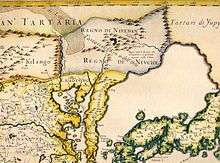Qing dynasty
| Qing dynasty | ||||||||||
| 清朝 ᡩᠠᡳᠴᡳᠩ ᡤᡠᡵᡠᠨ | ||||||||||
| ||||||||||
| ||||||||||
| Anthem 《鞏金甌》 "Gong Jin'ou" ("Cup of Solid Gold") | ||||||||||
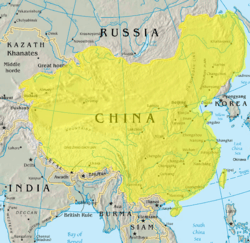 Qing dynasty in 1765 | ||||||||||
| Capital | Beijing (Shuntian Prefecture) | |||||||||
| Languages | Mandarin, Manchu, Mongolian, Tibetan, Turki (Modern Uighur),[1] numerous regional languages and varieties of Chinese | |||||||||
| Religion | Heaven worship, Buddhism, Chinese folk religion, Confucianism, Taoism, Christianity, Islam, Shamanism, others | |||||||||
| Government | Absolute monarchy (1644–1911) Constitutional monarchy (1911–12)[2] | |||||||||
| Emperor | ||||||||||
| • | 1644–1661 | Shunzhi (first) | ||||||||
| • | 1908–1912 | Puyi (last) | ||||||||
| Regent | ||||||||||
| • | 1908–12 | Zaifeng | ||||||||
| Prime Minister | ||||||||||
| • | 1911 | Yikuang | ||||||||
| • | 1911–12 | Yuan Shikai | ||||||||
| Historical era | Imperial era | |||||||||
| • | Qing conquest of the Ming | 1644 | ||||||||
| • | First Opium War | 1839–42 | ||||||||
| • | Second Opium War | 1856–60 | ||||||||
| • | Sino-Japanese War | 1 August 1894 – 17 April 1895 | ||||||||
| • | Xinhai Revolution | 10 October 1911 | ||||||||
| • | Abdication of Puyi | 12 February 1912 | ||||||||
| Area | ||||||||||
| • | 1790[3][4] | 14,700,000 km² (5,675,702 sq mi) | ||||||||
| Population | ||||||||||
| • | 1740 est. | 140,000,000 | ||||||||
| • | 1776 est. | 268,238,000 | ||||||||
| • | 1790 est. | 301,000,000 | ||||||||
| Currency | Cash (wén)
Tael (liǎng) | |||||||||
| ||||||||||
| Today part of | ||||||||||
| Qing dynasty | |||||||||||||||||||||||||||
|
"Qing dynasty" in Chinese (top) and Manchu (bottom) | |||||||||||||||||||||||||||
| Chinese name | |||||||||||||||||||||||||||
|---|---|---|---|---|---|---|---|---|---|---|---|---|---|---|---|---|---|---|---|---|---|---|---|---|---|---|---|
| Chinese | 清朝 | ||||||||||||||||||||||||||
| |||||||||||||||||||||||||||
| Great Qing | |||||||||||||||||||||||||||
| Traditional Chinese | 大清 | ||||||||||||||||||||||||||
| Simplified Chinese | 大清 | ||||||||||||||||||||||||||
| |||||||||||||||||||||||||||
| Manchu name | |||||||||||||||||||||||||||
| Manchu script |
ᡩᠠᡳᠴᡳᠩ ᡤᡠᡵᡠᠨ | ||||||||||||||||||||||||||
| Abkai | Daiqing gurun | ||||||||||||||||||||||||||
| Möllendorff | Daicing gurun | ||||||||||||||||||||||||||
 | |||||||
|---|---|---|---|---|---|---|---|
| ANCIENT | |||||||
| Neolithic c. 8500 – c. 2070 BCE | |||||||
| Xia dynasty c. 2070 – c. 1600 BCE | |||||||
| Shang dynasty c. 1600 – c. 1046 BCE | |||||||
| Zhou dynasty c. 1046 – 256 BCE | |||||||
| Western Zhou | |||||||
| Eastern Zhou | |||||||
| Spring and Autumn | |||||||
| Warring States | |||||||
| IMPERIAL | |||||||
| Qin dynasty 221–206 BCE | |||||||
| Han dynasty 206 BCE – 220 CE | |||||||
| Western Han | |||||||
| Xin dynasty | |||||||
| Eastern Han | |||||||
| Three Kingdoms 220–280 | |||||||
| Wei, Shu and Wu | |||||||
| Jin dynasty 265–420 | |||||||
| Western Jin | |||||||
| Eastern Jin | Sixteen Kingdoms | ||||||
| Northern and Southern dynasties 420–589 | |||||||
| Sui dynasty 581–618 | |||||||
| Tang dynasty 618–907 | |||||||
| (Second Zhou dynasty 690–705) | |||||||
| Five Dynasties and Ten Kingdoms 907–960 |
Liao dynasty 907–1125 | ||||||
| Song dynasty 960–1279 |
|||||||
| Northern Song | Western Xia | ||||||
| Southern Song | Jin | ||||||
| Yuan dynasty 1271–1368 | |||||||
| Ming dynasty 1368–1644 | |||||||
| Qing dynasty 1644–1911 | |||||||
| MODERN | |||||||
| Republic of China 1912–1949 | |||||||
| People's Republic of China 1949–present |
Republic of China (Taiwan) 1949–present | ||||||
The Qing dynasty (English /tʃɪŋ/), officially the Great Qing, also called the Empire of the Great Qing or the Manchu dynasty, was the last imperial dynasty of China, ruling from 1644 to 1912 with a brief, abortive restoration in 1917. It was preceded by the Ming dynasty and succeeded by the Republic of China. The Qing multi-cultural empire lasted almost three centuries and formed the territorial base for the modern Chinese state.
The dynasty was founded by the Jurchen Aisin Gioro clan in Manchuria. In the late sixteenth century, Nurhaci, originally a Ming vassal, began organizing "Banners", military-social units that included Jurchen, Han Chinese, and Mongol elements. Nurhaci formed the Jurchen clans into a unified entity, which became known as Manchus. By 1636, his son Hong Taiji began driving Ming forces out of Liaodong and declared a new dynasty, the Qing. In 1644, peasant rebels led by Li Zicheng conquered the Ming capital Beijing. Rather than serve them, Ming general Wu Sangui made an alliance with the Manchus and opened the Shanhai Pass to the Banner Armies led by Prince Dorgon, who defeated the rebels and seized Beijing. The conquest of China proper was not completed until 1683 under the Kangxi Emperor (r. 1661–1722). The Ten Great Campaigns of the Qianlong Emperor from the 1750s to the 1790s extended Qing control into Central Asia. While the early rulers maintained their Manchu ways, and while their official title was Emperor they were known as khans to the Mongols and patronized Tibetan Buddhism, they governed using Confucian styles and institutions of bureaucratic government. They retained the imperial examinations to recruit Han Chinese to work under or in parallel with Manchus. They also adapted the ideals of the tributary system in dealing with neighboring territories.
The reign of the Qianlong Emperor (1735–1796) saw the dynasty's apogee and initial decline in prosperity and imperial control. The population rose to some 400 million, but taxes and government revenues were fixed at a low rate, virtually guaranteeing eventual fiscal crisis. Corruption set in, rebels tested government legitimacy, and ruling elites did not change their mindsets in the face of changes in the world system. Following the Opium War, European powers imposed unequal treaties, free trade, extraterritoriality and treaty ports under foreign control. The Taiping Rebellion (1850–64) and the Dungan Revolt (1862–77) in Central Asia led to the deaths of some 20 million people, most of them due to famines caused by war. In spite of these disasters, in the Tongzhi Restoration of the 1860s, Han Chinese elites rallied to the defense of the Confucian order and the Qing rulers. The initial gains in the Self-Strengthening Movement were destroyed in the First Sino-Japanese War of 1895, in which the Qing lost its influence over Korea and the possession of Taiwan. New Armies were organized, but the ambitious Hundred Days' Reform of 1898 was turned back by Empress Dowager Cixi, a conservative leader. When the Scramble for Concessions by foreign powers triggered the violently anti-foreign Yihetuan ("Boxers"), the foreign powers invaded China, the Empress Dowager declared war on them, leading to defeat and the flight of the Imperial Court to Xi'an.
After agreeing to sign the Boxer Protocol the government then initiated unprecedented fiscal and administrative reforms, including elections, a new legal code, and abolition of the examination system. Sun Yat-sen and other revolutionaries competed with reformers such as Liang Qichao and monarchists such as Kang Youwei to transform the Qing empire into a modern nation. After the death of Empress Dowager Cixi and the Guangxu Emperor in 1908, the hardline Manchu court alienated reformers and local elites alike. Local uprisings starting on October 11, 1911 led to the Xinhai Revolution. Puyi, the last emperor, abdicated on February 12, 1912.
Names
Nurhaci declared himself the "Bright Khan" of the Later Jin (lit. "gold") state in honor both of the 12–13th century Jurchen Jin dynasty and of his Aisin Gioro clan (Aisin being Manchu for the Chinese 金 (jīn, "gold")).[5] His son Hong Taiji renamed the dynasty Great Qing in 1636.[6] There are competing explanations on the meaning of Qīng (lit. "clear" or "pure"). The name may have been selected in reaction to the name of the Ming dynasty (明), which consists of the Chinese characters for "sun" (日) and "moon" (月), both associated with the fire element of the Chinese zodiacal system. The character Qīng (清) is composed of "water" (氵) and "azure" (青), both associated with the water element. This association would justify the Qing conquest as defeat of fire by water. The water imagery of the new name may also have had Buddhist overtones of perspicacity and enlightenment and connections with the Bodhisattva Manjusri.[7] The Manchu name daicing, which sounds like a phonetic rendering of Dà Qīng or Dai Ching, may in fact have been derived from a Mongolian word that means "warrior". Daicing gurun may therefore have meant "warrior state", a pun that was only intelligible to Manchu and Mongol people. In the later part of the dynasty, however, even the Manchus themselves had forgotten this possible meaning.[8]
After conquering "China proper", the Manchus identified their state as "China" (中國, Zhōngguó; "Middle Kingdom"), and referred to it as Dulimbai Gurun in Manchu (Dulimbai means "central" or "middle," gurun means "nation" or "state"). The emperors equated the lands of the Qing state (including present-day Northeast China, Xinjiang, Mongolia, Tibet and other areas) as "China" in both the Chinese and Manchu languages, defining China as a multi-ethnic state, and rejecting the idea that "China" only meant Han areas. The Qing emperors proclaimed that both Han and non-Han peoples were part of "China". They used both "China" and "Qing" to refer to their state in official documents, international treaties (as the Qing was known internationally as "China"[9] or the "Chinese Empire"[10]) and foreign affairs, and "Chinese language" (Dulimbai gurun i bithe) included Chinese, Manchu, and Mongol languages, and "Chinese people" (中國之人 Zhōngguó zhī rén; Manchu: Dulimbai gurun i niyalma) referred to all subjects of the empire.[11] In the Chinese-language versions of its treaties and its maps of the world, the Qing government used "Qing" and "China" interchangeably.[12]
History
Formation of the Manchu state
The Qing dynasty was founded not by Han Chinese, who constitute the majority of the Chinese population, but by a sedentary farming people known as the Jurchen, a Tungusic people who lived around the region now comprising the Chinese provinces of Jilin and Heilongjiang.[13] The Manchus are sometimes mistaken for a nomadic people,[14] which they were not.[15][16] What was to become the Manchu state was founded by Nurhaci, the chieftain of a minor Jurchen tribe – the Aisin Gioro – in Jianzhou in the early 17th century. Originally a vassal of the Ming emperors, Nurhachi embarked on an intertribal feud in 1582 that escalated into a campaign to unify the nearby tribes. By 1616, he had sufficiently consolidated Jianzhou so as to be able to proclaim himself Khan of the Great Jin in reference to the previous Jurchen dynasty.[17]
Two years later, Nurhachi announced the "Seven Grievances" and openly renounced the sovereignty of Ming overlordship in order to complete the unification of those Jurchen tribes still allied with the Ming emperor. After a series of successful battles, he relocated his capital from Hetu Ala to successively bigger captured Ming cities in Liaodong Peninsula: first Liaoyang in 1621, then Shenyang (Mukden) in 1625.[17]
Relocating his court from Jianzhou to Liaodong provided Nurhachi access to more resources; it also brought him in close contact with the Khorchin Mongol domains on the plains of Mongolia. Although by this time the once-united Mongol nation had long since fragmented into individual and hostile tribes, these tribes still presented a serious security threat to the Ming borders. Nurhachi's policy towards the Khorchins was to seek their friendship and cooperation against the Ming, securing his western border from a powerful potential enemy.[18]
Furthermore, the Khorchin proved a useful ally in the war, lending the Jurchens their expertise as cavalry archers. To guarantee this new alliance, Nurhachi initiated a policy of inter-marriages between the Jurchen and Khorchin nobilities, while those who resisted were met with military action. This is a typical example of Nurhachi's initiatives that eventually became official Qing government policy. During most of the Qing period, the Mongols gave military assistance to the Manchus.[18]
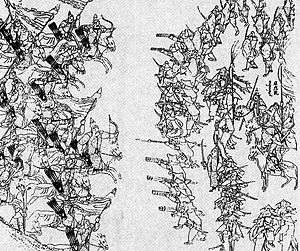
Some of Nurhaci's other important contributions include ordering the creation of a written Manchu script based on the Mongolian after the earlier Jurchen script was forgotten which had been derived from Khitan and Chinese and the creation of the civil and military administrative system which eventually evolved into the Eight Banners, the defining element of Manchu identity and the foundation for transforming the loosely knitted Jurchen tribes into a nation.
There were too few ethnic Manchus to conquer China, so they gained strength by defeating and absorbing Mongols, but more importantly, adding Han Chinese to the Eight Banners.[19] The Manchus had to create an entire "Jiu Han jun" (Old Han Army) due to the massive amount of Han Chinese soldiers which were absorbed into the Eight Banners by both capture and defection, Ming artillery was responsible for many victories against the Manchus, so the Manchus established an artillery corps made out of Han Chinese soldiers in 1641 and the swelling of Han Chinese numbers in the Eight Banners led in 1642 of all Eight Han Banners being created.[20] It was defected Ming Han Chinese armies which conquered southern China for the Qing.[21]
Han defectors played a massive role in the Qing conquest of China. Han Chinese Generals who defected to the Manchu were often given women from the Imperial Aisin Gioro family in marriage while the ordinary soldiers who defected were often given non-royal Manchu women as wives.[22][23] Jurchen (Manchu) women married Han Chinese defectors in Liaodong.[24] Manchu Aisin Gioro princesses were also married to Han Chinese official's sons.[25]
Nurhachi's unbroken series of military successes came to an end in January 1626 when he was defeated by Yuan Chonghuan while laying siege to Ningyuan. He died a few months later and was succeeded by his eighth son, Hong Taiji, who emerged after a short political struggle amongst other potential contenders as the new Khan.
Although Hong Taiji was an experienced leader and the commander of two Banners at the time of his succession, his reign did not start well on the military front. The Jurchens suffered yet another defeat in 1627 at the hands of Yuan Chonghuan. As before, this defeat was, in part, due to the Ming's newly acquired Portuguese cannons.
To redress the technological and numerical disparity, Hong Taiji in 1634 created his own artillery corps, the ujen chooha, Chinese: 重軍 from among his existing Han troops who cast their own cannons in the European design with the help of defector Chinese metallurgists. In 1635, the Manchus' Mongol allies were fully incorporated into a separate Banner hierarchy under direct Manchu command. Hong Taiji then proceeded in 1636 to invade Korea again.
After the Second Manchu invasion of Korea, Joseon Korea was forced to give several of their royal princesses as concubines to the Qing Manchu regent Prince Dorgon.[26] 1650 Dorgon married the Korean Princess I-shun (義/願).[27]
This was followed by the creation of the first two Han Banners in 1637 (increasing to eight in 1642). Together these military reforms enabled Hong Taiji to resoundingly defeat Ming forces in a series of battles from 1640 to 1642 for the territories of Songshan and Jinzhou. This final victory resulted in the surrender of many of the Ming dynasty's most battle-hardened troops, the death of Yuan Chonghuan at the hands of the Chongzhen Emperor (who thought Yuan had betrayed him), and the complete and permanent withdrawal of the remaining Ming forces north of the Great Wall.
Meanwhile, Hong Taiji set up a rudimentary bureaucratic system based on the Ming model. He established six boards or executive level ministries in 1631 to oversee finance, personnel, rites, military, punishments, and public works. However, these administrative organs had very little role initially, and it was not until the eve of completing the conquest ten years later that they fulfilled their government roles.[28]
Hong Taiji's bureaucracy was staffed with many Han Chinese, including many newly surrendered Ming officials. The Manchus' continued dominance was ensured by an ethnic quota for top bureaucratic appointments. Hong Taiji's reign also saw a fundamental change of policy towards his Han Chinese subjects. Nurhaci had treated Han in Liaodong differently according to how much grain they had, those with less than 5 to 7 sin were treated like chattel while those with more than that amount were rewarded with property. Due to a revolt by Han in Liaodong in 1623, Nurhachi, who previously gave concessions to conquered Han subjects in Liaodong, turned against them and ordered that they no longer be trusted; He enacted discriminatory policies and killings against them, while ordering that Han who assimilated to the Jurchen (in Jilin) before 1619 be treated equally as Jurchens were and not like the conquered Han in Liaodong. Hong Taiji instead incorporated them into the Jurchen "nation" as full (if not first-class) citizens, obligated to provide military service. By 1648, less than one-sixth of the bannermen were of Manchu ancestry.[29] This change of policy not only increased Hong Taiji's manpower and reduced his military dependence on banners not under his personal control, it also greatly encouraged other Han Chinese subjects of the Ming dynasty to surrender and accept Jurchen rule when they were defeated militarily. Through these and other measures Hong Taiji was able to centralize power unto the office of the Khan, which in the long run prevented the Jurchen federation from fragmenting after his death.
Hong Taiji recognized that Ming Han Chinese defectors were needed by the Manchus in order to assist in the conquest of the Ming, explaining to other Manchus why he needed to treat the Ming defector General Hong Chengchou leniently.[30]
One of the defining events of Hong Taiji's reign was the official adoption of the name "Manchu" for the united Jurchen people in November, 1635. The next year, when he is said to be presented with the imperial seal of the Yuan dynasty after the defeat of the last Khagan of the Mongols, Hong Taiji renamed his state from "Great Jin" to "Great Qing" and elevated his position from Khan to Emperor, suggesting imperial ambitions beyond unifying the Manchu territories.
Claiming the Mandate of Heaven
.jpg)
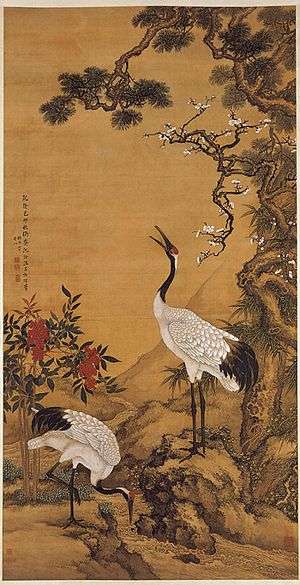
Hong Taiji died suddenly in September 1643 without a designated heir. As the Jurchens had traditionally "elected" their leader through a council of nobles, the Qing state did not have in place a clear succession system until the reign of the Kangxi Emperor. The leading contenders for power at this time were Hong Taiji's oldest son Hooge and Hong Taiji' half brother Dorgon. A compromise candidate in the person of Hong Taiji's five-year-old son, Fulin, was installed as the Shunzhi Emperor, with Dorgon as regent and de facto leader of the Manchu nation.
Ming government officials fought against each other, against fiscal collapse, and against a series of peasant rebellions. They were unable to capitalise on the Manchu succession dispute and installation of a minor as emperor. In April 1644, the capital at Beijing was sacked by a coalition of rebel forces led by Li Zicheng, a former minor Ming official, who established a short-lived Shun dynasty. The last Ming ruler, the Chongzhen Emperor, committed suicide when the city fell, marking the official end of the dynasty.
Li Zicheng then led a coalition of rebel forces numbering 200,000[lower-alpha 1] to confront Wu Sangui, the general commanding the Ming garrison at Shanhai Pass. Shanhai Pass is a pivotal pass of the Great Wall, located fifty miles northeast of Beijing, and for years its defenses kept the Manchus from directly raiding the Ming capital. Wu Sangui, caught between a rebel army twice his size and a foreign enemy he had fought for years, decided to cast his lot with the Manchus, with whom he was familiar. Wu Sangui may have been influenced by Li Zicheng's mistreatment of his family and other wealthy and cultured officials; it was said that Li also took Wu's concubine Chen Yuanyuan for himself. Wu and Dorgon allied in the name of avenging the death of the Chongzhen Emperor. Together, the two former enemies met and defeated Li Zicheng's rebel forces in battle on May 27, 1644.[31]
The newly allied armies captured Beijing on June 6. The Shunzhi Emperor was invested as the "Son of Heaven" on October 30. The Manchus, who had positioned themselves as political heir to the Ming emperor by defeating the rebel Li Zicheng, completed the symbolic transition by holding a formal funeral for the Chongzhen Emperor. However the process of conquering the rest of China took another seventeen years of battling Ming loyalists, pretenders and rebels. The last Ming pretender, Prince Gui, sought refuge with the King of Burma, but was turned over to a Qing expeditionary army commanded by Wu Sangui, who had him brought back to Yunnan province and executed in early 1662.
Han Chinese Banners were made up of Han Chinese who defected to the Qing up to 1644 and joined the Eight Banners, giving them social and legal privileges in addition to being acculturated to Manchu culture. So many Han defected to the Qing and swelled the ranks of the Eight Banners that ethnic Manchus became a minority, making up only 16% in 1648, with Han Bannermen dominating at 75% and Mongol Bannermen making up the rest.[32] This multi-ethnic force in which Manchus were only a minority conquered China for the Qing.[33]
Han Chinese Bannermen were responsible for the successful Qing conquest of China, as they made up the majority of governors in the early Qing, and they governed and administered China after the conquest, stabilizing Qing rule.[34] Han Bannermen dominated the post of governor-general in the time of the Shunzhi and Kangxi Emperors, and also the post of governor, largely excluding ordinary Han civilians from these posts.[35]
The Qing showed that the Manchus valued military skills in propaganda targeted towards the Ming military to get them to defect to the Qing, since the Ming civilian political system discriminated against the military.[36] The three Liaodong Han Bannermen officers who played a massive role in the conquest of southern China from the Ming were Shang Kexi, Geng Zhongming, and Kong Youde and they governed southern China autonomously as viceroys for the Qing after their conquests.[37] Normally the Manchu Bannermen acted only as reserve forces or in the rear and were used predominantly for quick strikes with maximum impact, so as to minimize ethnic Manchu losses; instead, the Qing used defected Han Chinese troops to fight as the vanguard during the entire conquest of China.[38]
Among the Banners, gunpowder weapons like muskets and artillery were specifically wielded by the Chinese Banners.[39]
To promote ethnic harmony, a 1648 decree from Shunzhi allowed Han Chinese civilian men to marry Manchu women from the Banners with the permission of the Board of Revenue if they were registered daughters of officials or commoners or the permission of their banner company captain if they were unregistered commoners, it was only later in the dynasty that these policies allowing intermarriage were done away with.[40]
The southern cadet branch of Confucius' descendants who held the title Wujing boshi and the northern branch 65th generation descendant to hold the title Duke Yansheng had both their titles confirmed by the Qing Shunzhi Emperor upon the Qing conquest of the Ming and entry into Beijing on 31 October.[41] The Kong's title of Duke was maintained by the Qing.[42]

The first seven years of the Shunzhi Emperor's reign were dominated by the regent prince Dorgon. Because of his own political insecurity, Dorgon followed Hong Taiji's example by ruling in the name of the emperor at the expense of rival Manchu princes, many of whom he demoted or imprisoned under one pretext or another. Although the period of his regency was relatively short, Dorgon cast a long shadow over the Qing dynasty.
First, the Manchus had entered "China proper" because Dorgon responded decisively to Wu Sangui's appeal. Then, after capturing Beijing, instead of sacking the city as the rebels had done, Dorgon insisted, over the protests of other Manchu princes, on making it the dynastic capital and reappointing most Ming officials. Choosing Beijing as the capital had not been a straightforward decision, since no major Chinese dynasty had directly taken over its immediate predecessor's capital. Keeping the Ming capital and bureaucracy intact helped quickly stabilize the regime and sped up the conquest of the rest of the country. Dorgon drastically reduced the influence of the eunuchs, a major force in the Ming bureaucracy, and directed Manchu women not to bind their feet in the Chinese style.[43]
However, not all of Dorgon's policies were equally popular nor easily implemented. The controversial July 1645 edict (the "haircutting order") forced adult Han Chinese men to shave the front of their heads and comb the remaining hair into the queue hairstyle which was worn by Manchu men, on pain of death.[44] The popular description of the order was: "To keep the hair, you lose the head; To keep your head, you cut the hair."[43] To the Manchus, this policy was a test of loyalty and an aid in distinguishing friend from foe. For the Han Chinese, however, it was a humiliating reminder of Qing authority that challenged traditional Confucian values. The Classic of Filial Piety (Xiaojing) held that "a person's body and hair, being gifts from one's parents, are not to be damaged." Under the Ming dynasty, adult men did not cut their hair but instead wore it in the form of a top-knot.[45] The order triggered strong resistance to Qing rule in Jiangnan[46] and massive killing of Han Chinese. It was Han Chinese defectors who carried out massacres against people refusing to wear the queue. Li Chengdong, a Han Chinese general who had served the Ming but surrendered to the Qing,[47] ordered his Han troops to carry out three separate massacres in the city of Jiading within a month, resulting in tens of thousands of deaths. At the end of the third massacre, there was hardly a living person left in this city.[48] Jiangyin also held out against about 10,000 Han Chinese Qing troops for 83 days. When the city wall was finally breached on 9 October 1645, the Han Chinese Qing army led by the Han Chinese Ming defector Liu Liangzuo (劉良佐), who had been ordered to "fill the city with corpses before you sheathe your swords," massacred the entire population, killing between 74,000 and 100,000 people.[49] The queue was the only aspect of Manchu culture which the Qing forced on the common Han population. The Qing required people serving as officials to wear Manchu clothing, but allowed non-official Han civilians to continue wearing Hanfu (Han clothing).
On December 31, 1650, Dorgon suddenly died during a hunting expedition, marking the official start of the Shunzhi Emperor's personal rule. Because the emperor was only 12 years old at that time, most decisions were made on his behalf by his mother, Empress Dowager Xiaozhuang, who turned out to be a skilled political operator.
Although his support had been essential to Shunzhi's ascent, Dorgon had centralised so much power in his hands as to become a direct threat to the throne. So much so that upon his death he was bestowed the extraordinary posthumous title of Emperor Yi (Chinese: 義皇帝), the only instance in Qing history in which a Manchu "prince of the blood" (Chinese: 親王) was so honored. Two months into Shunzhi's personal rule, however, Dorgon was not only stripped of his titles, but his corpse was disinterred and mutilated.[lower-alpha 2] to atone for multiple "crimes", one of which was persecuting to death Shunzhi’s agnate eldest brother, Hooge. More importantly, Dorgon's symbolic fall from grace also led to the purge of his family and associates at court, thus reverting power back to the person of the emperor. After a promising start, Shunzhi's reign was cut short by his early death in 1661 at the age of twenty-four from smallpox. He was succeeded by his third son Xuanye, who reigned as the Kangxi Emperor.
The Manchus sent Han Bannermen to fight against Koxinga's Ming loyalists in Fujian.[50] They removed the population from coastal areas in order to deprive Koxinga's Ming loyalists of resources. This led to a misunderstanding that Manchus were "afraid of water". Han Bannermen carried out the fighting and killing, casting doubt on the claim that fear of the water led to the coastal evacuation and ban on maritime activities.[51] Even though a poem refers to the soldiers carrying out massacres in Fujian as "barbarians", both Han Green Standard Army and Han Bannermen were involved and carried out the worst slaughter.[52] 400,000 Green Standard Army soldiers were used against the Three Feudatories in addition to the 200,000 Bannermen.[53]
The Kangxi Emperor's reign and consolidation
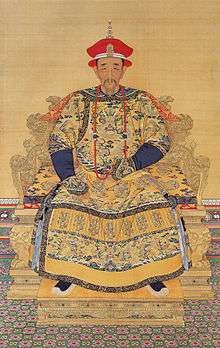
The sixty-one year reign of the Kangxi Emperor was the longest of any Chinese emperor. Kangxi's reign is also celebrated as the beginning of an era known as the "High Qing", during which the dynasty reached the zenith of its social, economic and military power. Kangxi's long reign started when he was eight years old upon the untimely demise of his father. To prevent a repeat of Dorgon's dictatorial monopolizing of power during the regency, the Shunzhi Emperor, on his deathbed, hastily appointed four senior cabinet ministers to govern on behalf of his young son. The four ministers — Sonin, Ebilun, Suksaha, and Oboi — were chosen for their long service, but also to counteract each other's influences. Most important, the four were not closely related to the imperial family and laid no claim to the throne. However, as time passed, through chance and machination, Oboi, the most junior of the four, achieved such political dominance as to be a potential threat. Even though Oboi's loyalty was never an issue, his personal arrogance and political conservatism led him into an escalating conflict with the young emperor. In 1669 Kangxi, through trickery, disarmed and imprisoned Oboi — a significant victory for a fifteen-year-old emperor over a wily politician and experienced commander.

The early Manchu rulers established two foundations of legitimacy which help to explain the stability of their dynasty. The first was the bureaucratic institutions and the neo-Confucian culture which they adopted from earlier dynasties.[54] Manchu rulers and Han Chinese scholar-official elites gradually came to terms with each other. The examination system offered a path for ethnic Han to become officials. Imperial patronage of Kangxi Dictionary demonstrated respect for Confucian learning, while the Sacred Edict of 1670 effectively extolled Confucian family values. His attempts to discourage Chinese women from foot binding, however, were unsuccessful.
The second major source of stability was the Central Asian aspect of their Manchu identity which allowed them to appeal to Mongol, Tibetan and Uighur constituents. The Qing used the title of Emperor (Huangdi) in Chinese while among Mongols the Qing monarch was referred to as Bogda khan (wise Khan), and referred to as Gong Ma in Tibet.[55] Qianlong propagated the image of himself as Buddhist sage rulers, patrons of Tibetan Buddhism.[56] In the Manchu language, the Qing monarch was alternately referred to as either Huwangdi (Emperor) or Khan with no special distinction between the two usages. The Kangxi Emperor also welcomed to his court Jesuit missionaries, who had first come to China under the Ming. Missionaries including Tomás Pereira, Martino Martini, Johann Adam Schall von Bell, Ferdinand Verbiest and Antoine Thomas held significant positions as military weapons experts, mathematicians, cartographers, astronomers and advisers to the emperor. The relationship of trust was however lost in the later Chinese Rites controversy.
Yet controlling the "Mandate of Heaven" was a daunting task. The vastness of China's territory meant that there were only enough banner troops to garrison key cities forming the backbone of a defense network that relied heavily on surrendered Ming soldiers. In addition, three surrendered Ming generals were singled out for their contributions to the establishment of the Qing dynasty, ennobled as feudal princes (藩王), and given governorships over vast territories in Southern China. The chief of these was Wu Sangui, who was given the provinces of Yunnan and Guizhou, while generals Shang Kexi and Geng Jingzhong were given Guangdong and Fujian provinces respectively.
As the years went by, the three feudal lords and their extensive territories became increasingly autonomous. Finally, in 1673, Shang Kexi petitioned Kangxi for permission to retire to his hometown in Liaodong province and nominated his son as his successor. The young emperor granted his retirement, but denied the heredity of his fief. In reaction, the two other generals decided to petition for their own retirements to test Kangxi's resolve, thinking that he would not risk offending them. The move backfired as the young emperor called their bluff by accepting their requests and ordering that all three fiefdoms to be reverted to the crown.
Faced with the stripping of their powers, Wu Sangui, later joined by Geng Zhongming and by Shang Kexi's son Shang Zhixin, felt they had no choice but to revolt. The ensuing Revolt of the Three Feudatories lasted for eight years. Wu attempted, ultimately in vain, to fire the embers of south China Ming loyalty by restoring Ming customs, ordering that the resented queues be cut, and declaring himself emperor of a new dynasty. At the peak of the rebels' fortunes, they extended their control as far north as the Yangtze River, nearly establishing a divided China. Wu then hesitated to go further north, not being able to coordinate strategy with his allies, and Kangxi was able to unify his forces for a counterattack led by a new generation of Manchu generals. By 1681, the Qing government had established control over a ravaged southern China which took several decades to recover.[57]

Manchu Generals and Bannermen were initially put to shame by the better performance of the Han Chinese Green Standard Army. Kangxi accordingly assigned generals Sun Sike, Wang Jinbao, and Zhao Liangdong to crush the rebels, since he thought that Han Chinese were superior to Bannermen at battling other Han people .[58] Similarly, in northwestern China against Wang Fuchen, the Qing used Han Chinese Green Standard Army soldiers and Han Chinese generals as the primary military forces. This choice was due to the rocky terrain, which favoured infantry troops over cavalry, to the desire to keep Bannermen in reserve, and, again, to the belief that Han troops were better at fighting other Han people. These Han generals achieved victory over the rebels.[59] Also due to the mountainous terrain, Sichuan and southern Shaanxi were retaken by the Green Standard Army in 1680, with Manchus participating only in logistics and provisions.[60] 400,000 Green Standard Army soldiers and 150,000 Bannermen served on the Qing side during the war.[60] 213 Han Chinese Banner companies, and 527 companies of Mongol and Manchu Banners were mobilized by the Qing during the revolt.[39] 400,000 Green Standard Army soldiers were used against the Three Feudatories besides 200,000 Bannermen.[61]
The Qing forces were crushed by Wu from 1673-1674.[62] The Qing had the support of the majority of Han Chinese soldiers and Han elite against the Three Feudatories, since they refused to join Wu Sangui in the revolt, while the Eight Banners and Manchu officers fared poorly against Wu Sangui, so the Qing responded with using a massive army of more than 900,000 Han Chinese (non-Banner) instead of the Eight Banners, to fight and crush the Three Feudatories.[63] Wu Sangui's forces were crushed by the Green Standard Army, made out of defected Ming soldiers.[64]
To extend and consolidate the dynasty's control in Central Asia, the Kangxi Emperor personally led a series of military campaigns against the Dzungars in Outer Mongolia. The Kangxi Emperor was able to successfully expel Galdan's invading forces from these regions, which were then incorporated into the empire. Galdan was eventually killed in the Dzungar–Qing War. [65] In 1683, Qing forces received the surrender of Formosa (Taiwan) from Zheng Keshuang, grandson of Koxinga, who had conquered Taiwan from the Dutch colonists as a base against the Qing. Zheng Keshuang was awarded the title "Duke Haicheng" (海澄公) and was inducted into the Han Chinese Plain Red Banner of the Eight Banners when he moved to Beijing. Several Ming princes had accompanied Koxinga to Taiwan in 1661-1662, including the Prince of Ningjing Zhu Shugui and Prince Zhu Honghuan (朱弘桓), son of Zhu Yihai, where they lived in the Kingdom of Tungning. The Qing sent the 17 Ming princes still living on Taiwan in 1683 back to mainland China where they spent the rest of their lives in exile since their lives were spared from execution.[66] Winning Taiwan freed Kangxi's forces for series of battles over Albazin, the far eastern outpost of the Tsardom of Russia. Zheng's former soldiers on Taiwan like the rattan shield troops were also inducted into the Eight Banners and used by the Qing against Russian Cossacks at Albazin. The 1689 Treaty of Nerchinsk was China's first formal treaty with a European power and kept the border peaceful for the better part of two centuries. After Galdan's death, his followers, as adherents to Tibetan Buddhism, attempted to control the choice of the next Dalai Lama. Kangxi dispatched two armies to Lhasa, the capital of Tibet, and installed a Dalai Lama sympathetic to the Qing.[67]
By the end of the 17th century, China was at its greatest height of confidence and political control since the Ming dynasty.
Reigns of the Yongzheng and Qianlong emperors
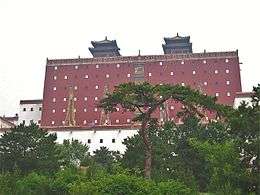
The reigns of the Yongzheng Emperor (r. 1723–1735) and his son, the Qianlong Emperor (r. 1735–1796), marked the height of Qing power. During this period, the Qing Empire ruled over 13 million square kilometers of territory.
After the Kangxi Emperor's death in the winter of 1722, his fourth son, Prince Yong (雍親王), became the Yongzheng Emperor. In the later years of Kangxi's reign, Yongzheng and his brothers had fought, and there were rumours that he had usurped the throne(most of the rumours believe that Yongzheng's brother Yingzhen (Kangxi's 14th son) is the real successor of Kangxi Emperor, the reason why Yingzhen failed to sit on the throne is because Yongzheng and his confidant Keduo Long tampered the content of Kangxi's testament at the night when Kangxi died), a charge for which there is little evidence. In fact, his father had trusted him with delicate political issues and discussed state policy with him. When Yongzheng came to power at the age of 45, he felt a sense of urgency about the problems which had accumulated in his father's later years and did not need instruction in how to exercise power.[68] In the words of one recent historian, he was "severe, suspicious, and jealous, but extremely capable and resourceful,"[69] and in the words of another, turned out to be an "early modern state-maker of the first order."[70]
He moved rapidly. First, he promoted Confucian orthodoxy and reversed what he saw as his father's laxness by cracking down on unorthodox sects and by decapitating an anti-Manchu writer his father had pardoned. In 1723 he outlawed Christianity and expelled Christian missionaries, though some were allowed to remain in the capital.[71] Next, he moved to control the government. He expanded his father's system of Palace Memorials which brought frank and detailed reports on local conditions directly to the throne without being intercepted by the bureaucracy, and created a small Grand Council of personal advisors which eventually grew into the emperor's de facto cabinet for the rest of the dynasty. He shrewdly filled key positions with Manchu and Han Chinese officials who depended on his patronage. When he began to realize that the financial crisis was even greater than he had thought, Yongzheng rejected his father's lenient approach to local landowning elites and mounted a campaign to enforce collection of the land tax. The increased revenues were to be used for "money to nourish honesty" among local officials and for local irrigation, schools, roads, and charity. Although these reforms were effective in the north, in the south and lower Yangzi valley, where Kangxi had wooed the elites, there were long established networks of officials and landowners. Yongzheng dispatched experienced Manchu commissioners to penetrate the thickets of falsified land registers and coded account books, but they were met with tricks, passivity, and even violence. The fiscal crisis persisted.[72]
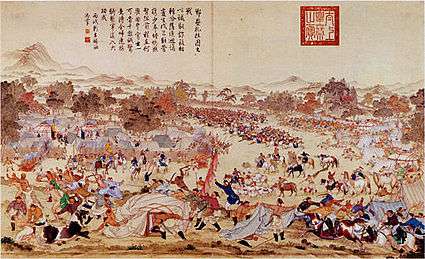
In 1725 Yongzheng bestowed the hereditary title of Marquis on a descendant of the Ming dynasty Imperial family, Zhu Zhiliang, who received a salary from the Qing government and whose duty was to perform rituals at the Ming tombs, and was also inducted the Chinese Plain White Banner in the Eight Banners. Later the Qianlong Emperor bestowed the title Marquis of Extended Grace posthumously on Zhu Zhuliang in 1750, and the title passed on through twelve generations of Ming descendants until the end of the Qing dynasty.
Yongzheng also inherited diplomatic and strategic problems. A team made up entirely of Manchus drew up the Treaty of Kyakhta (1727) to solidify the diplomatic understanding with Russia. In exchange for territory and trading rights, the Qing would have a free hand dealing with the situation in Mongolia. Yongzheng then turned to that situation, where the Zunghars threatened to re-emerge, and to the southwest, where local Miao chieftains resisted Qing expansion. These campaigns drained the treasury but established the emperor's control of the military and military finance.[73]
The Yongzheng Emperor died in 1735. His 24-year-old son, Prince Bao (寶親王), then became the Qianlong Emperor. Qianlong personally led military campaigns near Xinjiang and Mongolia, putting down revolts and uprisings in Sichuan and parts of southern China while expanding control over Tibet.
Qianlong's reign saw the launch of several ambitious cultural projects, including the compilation of the Siku Quanshu, or Complete Repository of the Four Branches of Literature. With a total of over 3,400 books, 79,000 chapters, and 36,304 volumes, the Siku Quanshu is the largest collection of books in Chinese history. Nevertheless, Qianlong used Literary Inquisition to silence opposition. The accusation of individuals began with the emperor's own interpretation of the true meaning of the corresponding words. If the emperor decided these were derogatory or cynical towards the dynasty, persecution would begin. Literary inquisition began with isolated cases at the time of Shunzhi and Kangxi, but became a pattern under Qianlong's rule, during which there were 53 cases of literary persecution.[74]
Beneath outward prosperity and imperial confidence, the later years of Qianlong's reign saw rampant corruption and neglect. Heshen, the emperor's handsome young favorite, took advantage of the emperor's indulgence to become one of the most corrupt officials in the history of the dynasty.[75] Qianlong's son, the Jiaqing Emperor (r. 1796–1820), eventually forced Heshen to commit suicide.
China also began suffering from mounting overpopulation during this period. Population growth was stagnant for the first half of the 17th century due to civil wars and epidemics, but prosperity and internal stability gradually reversed this trend. The introduction of new crops from the Americas such as the potato and peanut allowed an improved food supply as well, so that the total population of China during the 18th century ballooned from 100 million to 300 million people. Soon all available farmland was used up, forcing peasants to work ever-smaller and more intensely worked plots. The Qianlong Emperor once bemoaned the country's situation by remarking "The population continues to grow, but the land does not." The only remaining part of the empire that had arable farmland was Manchuria, where the provinces of Jilin and Heilongjiang had been walled off as a Manchu homeland. The emperor decreed for the first time that Han Chinese civilians were forbidden to settle.[76] Mongols were forbidden by the Qing from crossing the borders of their banners, even into other Mongol Banners and from crossing into neidi (the Han Chinese 18 provinces) and were given serious punishments if they did in order to keep the Mongols divided against each other to benefit the Qing.[77]
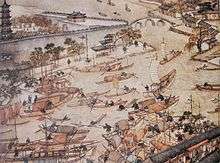
However Qing rule saw an massively increasing amount of Han Chinese both illegally and legally streaming into Manchuria and settling down to cultivate land as Manchu landlords desired Han Chinese peasants to rent on their land and grow grain, most Han Chinese migrants were not evicted as they went over the Great Wall and Willow Palisade, during the eighteenth century Han Chinese farmed 500,000 hectares of privately owned land in Manchuria and 203,583 hectares of lands which were part of coutrier stations, noble estates, and Banner lands, in garrisons and towns in Manchuria Han Chinese made up 80% of the population.[78]
Han Chinese farmers were resettled from north China by the Qing to the area along the Liao River in order to restore the land to cultivation.[79] Wasteland was reclaimed by Han Chinese squatters in addition to other Han who rented land from Manchu landlords.[80] Despite officially prohibiting Han Chinese settlement on the Manchu and Mongol lands, by the 18th century the Qing decided to settle Han refugees from northern China who were suffering from famine, floods, and drought into Manchuria and Inner Mongolia so that Han Chinese farmed 500,000 hectares in Manchuria and tens of thousands of hectares in Inner Mongolia by the 1780s.[81] Qianlong allowed Han Chinese peasants suffering from drought to move into Manchuria despite him issuing edicts in favor of banning them from 1740–1776.[82] Chinese tenant farmers rented or even claimed title to land from the "imperial estates" and Manchu Bannerlands in the area.[83] Besides moving into the Liao area in southern Manchuria, the path linking Jinzhou, Fengtian, Tieling, Changchun, Hulun, and Ningguta was settled by Han Chinese during the Qianlong Emperor's rule, and Han Chinese were the majority in urban areas of Manchuria by 1800.[84] To increase the Imperial Treasury's revenue, the Qing sold formerly Manchu only lands along the Sungari to Han Chinese at the beginning of the Daoguang Emperor's reign, and Han Chinese filled up most of Manchuria's towns by the 1840s according to Abbe Huc.[85]
In 1796, open rebellion by the White Lotus Society against the Qing government broke out. The White Lotus Rebellion continued for eight years, until 1804, and marked a turning point in the history of the Qing dynasty.[86]
Rebellion, unrest and external pressure
.jpg)
At the start of the dynasty, the Chinese empire continued to be the hegemonic power in East Asia. Although there was no formal ministry of foreign relations, the Lifan Yuan was responsible for relations with the Mongol and Tibetans in Central Asia, while the tributary system, a loose set of institutions and customs taken over from the Ming, in theory governed relations with East and Southeast Asian countries. The Treaty of Nerchinsk (1689) stabilized relations with Czarist Russia.
However, the 18th century saw the European empires gradually expand across the world, as European states developed economies built on maritime trade. The dynasty was confronted with newly developing concepts of the international system and state to state relations. European trading posts expanded into territorial control in nearby India and on the islands that are now Indonesia. The Qing response, successful for a time, was in 1756 to establish the Canton System, which restricted maritime trade to that city and gave monopoly trading rights to private Chinese merchants. The British East India Company and the Dutch East India Company had long before been granted similar monopoly rights by their governments.
In 1793, the British East India Company, with the support of the British government, sent a delegation to China under Lord George Macartney in order to open free trade and put relations on a basis of equality. The imperial court viewed trade as unimportant, whereas the British saw maritime trade as the key to their economy. The Qianlong Emperor told Macartney "the kings of the myriad nations come by land and sea with all sorts of precious things," and "consequently there is nothing we lack...."[87]

Demand in Europe for Chinese goods such as silk, tea, and ceramics could only be met if European companies funneled their limited supplies of silver into China. In the late 1700s, the governments of Britain and France were deeply concerned about the imbalance of trade and the drain of silver. To meet the growing Chinese demand for opium, the British East India Company greatly expanded its production in Bengal. Since China's economy was essentially self-sufficient, the country had little need to import goods or raw materials from the Europeans, so the usual way of payment was through silver. The Daoguang Emperor, concerned both over the outflow of silver and the damage that opium smoking was causing to his subjects, ordered Lin Zexu to end the opium trade. Lin confiscated the stocks of opium without compensation in 1839, leading Britain to send a military expedition the following year.
The First Opium War revealed the outdated state of the Chinese military. The Qing navy, composed entirely of wooden sailing junks, was severely outclassed by the modern tactics and firepower of the British Royal Navy. British soldiers, using advanced muskets and artillery, easily outmaneuvered and outgunned Qing forces in ground battles. The Qing surrender in 1842 marked a decisive, humiliating blow to China. The Treaty of Nanjing, the first of the unequal treaties, demanded war reparations, forced China to open up the five ports of Canton, Amoy, Fuchow, Ningpo and Shanghai to western trade and missionaries, and to cede Hong Kong Island to Britain. It revealed many inadequacies in the Qing government and provoked widespread rebellions against the already hugely unpopular regime.
The Taiping Rebellion in the mid-19th century was the first major instance of anti-Manchu sentiment threatening the stability of the dynasty. Hong Xiuquan, a failed civil service candidate, led the Taiping Rebellion, amid widespread social unrest and worsening famine. In 1851 Hong Xiuquan and others launched an uprising in Guizhou province, established the Taiping Heavenly Kingdom with Hong himself as king, claiming he often had visions of God and that he was the brother of Jesus Christ. Slavery, concubinage, arranged marriage, opium smoking, footbinding, judicial torture, and the worship of idols were all banned. However, success and subsequent authority and power led to internal feuds, defections and corruption. In addition, British and French troops, equipped with modern weapons, had come to the assistance of the Qing imperial army. It was not until 1864 that Qing armies under Zeng Guofan succeeded in crushing the revolt. The rebellion not only posed the most serious threat towards Qing rulers; it was also "bloodiest civil war of all time." Between 20 and 30 million people died during its fourteen-year course from 1850 to 1864.[88] After the outbreak of this rebellion, there were also revolts by the Muslims and Miao people of China against the Qing dynasty, most notably in the Miao Rebellion (1854–73) in Guizhou, the Panthay Rebellion (1856–1873) in Yunnan and the Dungan Revolt (1862–77) in the northwest.
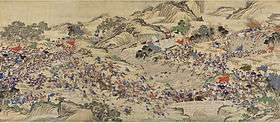
The Western powers, largely unsatisfied with the Treaty of Nanjing, gave grudging support to the Qing government during the Taiping and Nian Rebellions. China's income fell sharply during the wars as vast areas of farmland were destroyed, millions of lives were lost, and countless armies were raised and equipped to fight the rebels. In 1854, Britain tried to re-negotiate the Treaty of Nanjing, inserting clauses allowing British commercial access to Chinese rivers and the creation of a permanent British embassy at Beijing.
In 1856, Qing authorities, in searching for a pirate, boarded a ship, the Arrow, which the British claimed had been flying the British flag, an incident which led to the Second Opium War. In 1858, facing no other options, the Xianfeng Emperor agreed to the Treaty of Tientsin, which contained clauses deeply insulting to the Chinese, such as a demand that all official Chinese documents be written in English and a proviso granting British warships unlimited access to all navigable Chinese rivers.
Ratification of the treaty the following year led to resumption of hostilities and in 1860, with Anglo-French forces marching on Beijing, the emperor and his court fled the capital for the imperial hunting lodge at Rehe. Once in Beijing, the Anglo-French forces looted the Old Summer Palace, and in an act of revenge for the arrest of several Englishmen, burnt it to the ground. Prince Gong, a younger half-brother of the emperor, who had been left as his brother's proxy in the capital, was forced to sign the Convention of Beijing. Meanwhile, the humiliated emperor died the following year at Rehe.
Self-strengthening and the frustration of reforms
Yet the dynasty rallied. Chinese generals and officials such as Zuo Zongtang led the suppression of rebellions and stood behind the Manchus. When the Tongzhi Emperor came to the throne at the age of five in 1861, these officials rallied around him in what was called the Tongzhi Restoration. Their aim was to adopt western military technology in order to preserve Confucian values. Zeng Guofan, in alliance with Prince Gong, sponsored the rise of younger officials such as Li Hongzhang, who put the dynasty back on its feet financially and instituted the Self-Strengthening Movement. The reformers then proceeded with institutional reforms, including China's first unified ministry of foreign affairs, the Zongli Yamen; allowing foreign diplomats to reside in the capital; establishment of the Imperial Maritime Customs Service; the formation of modernized armies, such as the Beiyang Army, as well as a navy; and the purchase from Europeans of armament factories. [89]

The dynasty lost control of peripheral territories bit by bit. In return for promises of support against the British and the French, the Russian Empire took large chunks of territory in the Northeast in 1860. The period of cooperation between the reformers and the European powers ended with the Tientsin Massacre of 1870, which was incited by the murder of French nuns set off by the belligerence of local French diplomats. Starting with the Cochinchina Campaign in 1858, France expanded control of Indochina. By 1883, France was in full control of the region and had reached the Chinese border. The Sino-French War began with a surprise attack by the French on the Chinese southern fleet at Fuzhou. After that the Chinese declared war on the French. A French invasion of Taiwan was halted and the French were defeated on land in Tonkin at the Battle of Bang Bo. However Japan threatened to enter the war against China due to the Gapsin Coup and China chose to end the war with negotiations. The war ended in 1885 with the Treaty of Tientsin (1885) and the Chinese recognition of the French protectorate in Vietnam.[90]
In 1884, pro-Japanese Koreans in Seoul led the Gapsin Coup. Tensions between China and Japan rose after China intervened to suppress the uprising. Japanese Prime Minister Itō Hirobumi and Li Hongzhang signed the Convention of Tientsin, an agreement to withdraw troops simultaneously, but the First Sino-Japanese War of 1895 was a military humiliation. The Treaty of Shimonoseki recognized Korean independence and ceded Taiwan and the Pescadores to Japan. The terms might have been harsher, but when Japanese citizen attacked and wounded Li Hongzhang, an international outcry shamed the Japanese into revising them. The original agreement stipulated the cession of Liaodong Peninsula to Japan, but Russia, with its own designs on the territory, along with Germany and France, in what was known as the Triple Intervention, successfully put pressure on the Japanese to abandon the peninsula.
These years saw an evolution in the participation of Empress Dowager Cixi (Wade–Giles: Tz'u-Hsi) in state affairs. She entered the imperial palace in the 1850s as a concubine to the Xianfeng Emperor (r. 1850–1861) and came to power in 1861 after her five-year-old son, the Tongzhi Emperor ascended the throne. She, the Empress Dowager Ci'an (who had been Xianfeng's empress), and Prince Gong (a son of the Daoguang Emperor), staged a coup that ousted several regents for the boy emperor. Between 1861 and 1873, she and Ci'an served as regents, choosing the reign title "Tongzhi" (ruling together). Following the emperor's death in 1875, Cixi's nephew, the Guangxu Emperor, took the throne, in violation of the dynastic custom that the new emperor be of the next generation, and another regency began. In the spring of 1881, Ci'an suddenly died, aged only forty-three, leaving Cixi as sole regent. [91]
From 1889, when Guangxu began to rule in his own right, to 1898, the Empress Dowager lived in semi-retirement, spending the majority of the year at the Summer Palace. On November 1, 1897, two German Roman Catholic missionaries were murdered in the southern part of Shandong Province (the Juye Incident). In response, Germany used the murders as a pretext for a naval occupation of Jiaozhou Bay. The occupation prompted a "scramble for concessions" in 1898, which included the German lease of Jiazhou Bay, the Russian acquisition of Liaodong, and the British lease of the New Territories of Hong Kong.
In the wake of these external defeats, the Guangxu Emperor initiated the Hundred Days' Reform of 1898. Newer, more radical advisers such as Kang Youwei were given positions of influence. The emperor issued a series of edicts and plans were made to reorganize the bureaucracy, restructure the school system, and appoint new officials. Opposition from the bureaucracy was immediate and intense. Although she had been involved in the initial reforms, the empress dowager stepped in to call them off, arrested and executed several reformers, and took over day-to-day control of policy. Yet many of the plans stayed in place, and the goals of reform were implanted.[92]
Widespread drought in North China, combined with the imperialist designs of European powers and the instability of the Qing government, created conditions that led to the emergence of the Righteous and Harmonious Fists, or "Boxers." In 1900, local groups of Boxers proclaiming support for the Qing dynasty murdered foreign missionaries and large numbers of Chinese Christians, then converged on Beijing to besiege the Foreign Legation Quarter. A coalition of European, Japanese, and Russian armies (the Eight-Nation Alliance) then entered China without diplomatic notice, much less permission. Cixi declared war on all of these nations, only to lose control of Beijing after a short, but hard-fought campaign. She fled to Xi'an. The victorious allies drew up scores of demands on the Qing government, including compensation for their expenses in invading China and execution of complicit officials.[93]
Reform, revolution, collapse
By the early 20th century, mass civil disorder had begun in China, and it was growing continuously. To overcome such problems, Empress Dowager Cixi issued an imperial edict in 1901 calling for reform proposals from the governors-general and governors and initiated the era of the dynasty's "New Policies", also known as the "Late Qing Reform". The edict paved the way for the most far-reaching reforms in terms of their social consequences, including the creation of a national education system and the abolition of the imperial examinations in 1905.[94]
The Guangxu Emperor died on November 14, 1908, and on November 15, 1908, Cixi also died. Rumors held that she or Yuan Shikai ordered trusted eunuchs to poison the Guangxu Emperor, and an autopsy conducted nearly a century later confirmed lethal levels of arsenic in his corpse.[95] Puyi, the oldest son of Zaifeng, Prince Chun, and nephew to the childless Guangxu Emperor, was appointed successor at the age of two, leaving Zaifeng with the regency. This was followed by the dismissal of General Yuan Shikai from his former positions of power. In April 1911 Zaifeng created a cabinet in which there were two vice-premiers. Nonetheless, this cabinet was also known by contemporaries as "The Royal Cabinet" because among the thirteen cabinet members, five were members of the imperial family or Aisin Gioro relatives.[96] This brought a wide range of negative opinions from senior officials like Zhang Zhidong. The Wuchang Uprising of October 10, 1911, led to the creation of a new central government, the Republic of China, in Nanjing with Sun Yat-sen as its provisional head. Many provinces soon began "separating" from Qing control. Seeing a desperate situation unfold, the Qing government brought Yuan Shikai back to military power. He took control of his Beiyang Army to crush the revolution in Wuhan at the Battle of Yangxia. After taking the position of Prime Minister and creating his own cabinet, Yuan Shikai went as far as to ask for the removal of Zaifeng from the regency. This removal later proceeded with directions from Empress Dowager Longyu.
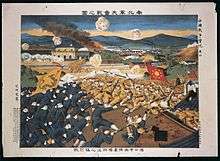
With Zaifeng gone, Yuan Shikai and his Beiyang commanders effectively dominated Qing politics. He reasoned that going to war would be unreasonable and costly, especially when noting that the Qing government had a goal for constitutional monarchy. Similarly, Sun Yat-sen's government wanted a republican constitutional reform, both aiming for the benefit of China's economy and populace. With permission from Empress Dowager Longyu, Yuan Shikai began negotiating with Sun Yat-sen, who decided that his goal had been achieved in forming a republic, and that therefore he could allow Yuan to step into the position of President of the Republic of China.
On 12 February 1912, after rounds of negotiations, Longyu issued an imperial edict bringing about the abdication of the child emperor Puyi. This brought an end to over 2,000 years of Imperial China and began an extended period of instability of warlord factionalism. The unorganized political and economic systems combined with a widespread criticism of Chinese culture led to questioning and doubt about the future. In the 1930s, the Empire of Japan invaded Northeast China and founded Manchukuo in 1932, with Puyi, as the emperor. After the invasion by the Soviet Union, Manchukuo collapsed in 1945.
Government
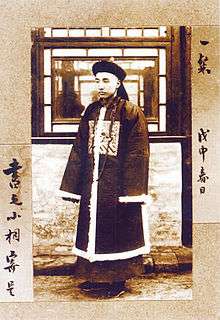
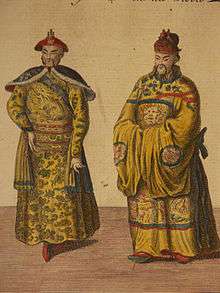
The early Qing emperors adopted the bureaucratic structures and institutions from the preceding Ming dynasty but split rule between Han Chinese and Manchus, with some positions also given to Mongols.[97] Like previous dynasties, the Qing recruited officials via the imperial examination system, until the system was abolished in 1905. The Qing divided the positions into civil and military positions, each having nine grades or ranks, each subdivided into a and b categories. Civil appointments ranged from an attendant to the emperor or a Grand Secretary in the Forbidden City (highest) to being a prefectural tax collector, deputy jail warden, deputy police commissioner, or tax examiner. Military appointments ranged from being a field marshal or chamberlain of the imperial bodyguard to a third class sergeant, corporal or a first or second class private.[98]
Central government agencies
The formal structure of the Qing government centered on the Emperor as the absolute ruler, who presided over six Boards (Ministries[lower-alpha 3]), each headed by two presidents[lower-alpha 4] and assisted by four vice presidents.[lower-alpha 5] In contrast to the Ming system, however, Qing ethnic policy dictated that appointments were split between Manchu noblemen and Han officials who had passed the highest levels of the state examinations. The Grand Secretariat,[lower-alpha 6] which had been an important policy-making body under the Ming, lost its importance during the Qing and evolved into an imperial chancery. The institutions which had been inherited from the Ming formed the core of the Qing "Outer Court," which handled routine matters and was located in the southern part of the Forbidden City.
In order not to let the routine administration take over the running of the empire, the Qing emperors made sure that all important matters were decided in the "Inner Court," which was dominated by the imperial family and Manchu nobility and which was located in the northern part of the Forbidden City. The core institution of the inner court was the Grand Council.[lower-alpha 7] It emerged in the 1720s under the reign of the Yongzheng Emperor as a body charged with handling Qing military campaigns against the Mongols, but it soon took over other military and administrative duties and served to centralize authority under the crown.[99] The Grand Councillors[lower-alpha 8] served as a sort of privy council to the emperor.
The Six Ministries and their respective areas of responsibilities were as follows:

Board of Civil Appointments[lower-alpha 9]
- The personnel administration of all civil officials – including evaluation, promotion, and dismissal. It was also in charge of the "honours list".
Board of Revenue[lower-alpha 10]
- The literal translation of the Chinese word hu (户) is "household". For much of Qing history, the government's main source of revenue came from taxation on landownership supplemented by official monopolies on salt, which was an essential household item, and tea. Thus, in the predominantly agrarian Qing dynasty, the "household" was the basis of imperial finance. The department was charged with revenue collection and the financial management of the government.
Board of Rites[lower-alpha 11]
- This board was responsible for all matters concerning court protocol. It organized the periodic worship of ancestors and various gods by the emperor, managed relations with tributary nations, and oversaw the nationwide civil examination system.
Board of War[lower-alpha 12]
- Unlike its Ming predecessor, which had full control over all military matters, the Qing Board of War had very limited powers. First, the Eight Banners were under the direct control of the emperor and hereditary Manchu and Mongol princes, leaving the ministry only with authority over the Green Standard Army. Furthermore, the ministry's functions were purely administrative. Campaigns and troop movements were monitored and directed by the emperor, first through the Manchu ruling council, and later through the Grand Council.
Board of Punishments[lower-alpha 13]
- The Board of Punishments handled all legal matters, including the supervision of various law courts and prisons. The Qing legal framework was relatively weak compared to modern day legal systems, as there was no separation of executive and legislative branches of government. The legal system could be inconsistent, and, at times, arbitrary, because the emperor ruled by decree and had final say on all judicial outcomes. Emperors could (and did) overturn judgements of lower courts from time to time. Fairness of treatment was also an issue under the system of control practised by the Manchu government over the Han Chinese majority. To counter these inadequacies and keep the population in line, the Qing government maintained a very harsh penal code towards the Han populace, but it was no more severe than previous Chinese dynasties.
%2C_Qing_Dynasty_postage_stamp.gif)
Board of Works[lower-alpha 14]
- The Board of Works handled all governmental building projects, including palaces, temples and the repairs of waterways and flood canals. It was also in charge of minting coinage.
From the early Qing, the central government was characterized by a system of dual appointments by which each position in the central government had a Manchu and a Han Chinese assigned to it. The Han Chinese appointee was required to do the substantive work and the Manchu to ensure Han loyalty to Qing rule.[100] The distinction between Han Chinese and Manchus extended to their court costumes. During the Qianlong Emperor's reign, for example, members of his family were distinguished by garments with a small circular emblem on the back, whereas Han officials wore clothing with a square emblem.
In addition to the six boards, there was a Lifan Yuan unique to the Qing government. This institution was established to supervise the administration of Tibet and the Mongol lands. As the empire expanded, it took over administrative responsibility of all minority ethnic groups living in and around the empire, including early contacts with Russia — then seen as a tribute nation. The office had the status of a full ministry and was headed by officials of equal rank. However, appointees were at first restricted only to candidates of Manchu and Mongol ethnicity, until later open to Han Chinese as well.
Even though the Board of Rites and Lifan Yuan performed some duties of a foreign office, they fell short of developing into a professional foreign service. It was not until 1861 — a year after losing the Second Opium War to the Anglo-French coalition — that the Qing government bowed to foreign pressure and created a proper foreign affairs office known as the Zongli Yamen. The office was originally intended to be temporary and was staffed by officials seconded from the Grand Council. However, as dealings with foreigners became increasingly complicated and frequent, the office grew in size and importance, aided by revenue from customs duties which came under its direct jurisdiction.
There was also another government institution called Imperial Household Department which was unique to the Qing dynasty. It was established before the fall of the Ming, but it became mature only after 1661, following the death of the Shunzhi Emperor and the accession of his son, the Kangxi Emperor.[101] The department's original purpose was to manage the internal affairs of the imperial family and the activities of the inner palace (in which tasks it largely replaced eunuchs), but it also played an important role in Qing relations with Tibet and Mongolia, engaged in trading activities (jade, ginseng, salt, furs, etc.), managed textile factories in the Jiangnan region, and even published books.[102] Relations with the Salt Superintendents and salt merchants, such as those at Yangzhou, were particularly lucrative, especially since they were direct, and did not go through absorptive layers of bureaucracy. The department was manned by booi,[lower-alpha 15] or "bondservants," from the Upper Three Banners.[103] By the 19th century, it managed the activities of at least 56 subagencies.[101][104]
Administrative divisions

Qing China reached its largest extent during the 18th century, when it ruled China proper (eighteen provinces) as well as the areas of present-day Northeast China, Inner Mongolia, Outer Mongolia, Xinjiang and Tibet, at approximately 13 million km2 in size. There were originally 18 provinces, all of which in China proper, but later this number was increased to 22, with Manchuria and Xinjiang being divided or turned into provinces. Taiwan, originally part of Fujian province, became a province of its own in the late 19th century, but was ceded to the Empire of Japan in 1895 following the First Sino-Japanese War. In addition, many surrounding countries, such as Korea (Joseon dynasty), Vietnam frequently paid tribute to China during much of this period. Khanate of Kokand were forced to submit as protectorate and pay tribute to the Qing dynasty in China between 1774 and 1798.
- Northern and southern circuits of Tian Shan (later became Xinjiang province) – sometimes the small semi-autonomous Kumul Khanate and Turfan Khanate are placed into an "Eastern Circuit"
- Outer Mongolia – Khalkha, Kobdo league, Köbsgöl, Tannu Urianha
- Inner Mongolia – 6 leagues (Jirim, Josotu, Juu Uda, Shilingol, Ulaan Chab, Ihe Juu)
- Other Mongolian leagues – Alshaa khoshuu (League-level khoshuu), Ejine khoshuu, Ili khoshuu (in Xinjiang), Köke Nuur league; directly ruled areas: Dariganga (Special region designated as Emperor's pasture), Guihua Tümed, Chakhar, Hulunbuir
- Tibet (Ü-Tsang and western Kham, approximately the area of present-day Tibet Autonomous Region)
- Manchuria (Northeast China, later became provinces)
- Eighteen provinces (China proper provinces)
- Additional provinces in the late Qing dynasty
|
Territorial administration

The Qing organization of provinces was based on the fifteen administrative units set up by the Ming dynasty, later made into eighteen provinces by splitting for example, Huguang into Hubei and Hunan provinces. The provincial bureaucracy continued the Yuan and Ming practice of three parallel lines, civil, military, and censorate, or surveillance. Each province was administered by a governor (巡撫, xunfu) and a provincial military commander (提督, tidu). Below the province were prefectures (府, fu) operating under a prefect (知府, zhīfǔ), followed by subprefectures under a subprefect. The lowest unit was the county, overseen by a county magistrate. The eighteen provinces are also known as "China proper". The position of viceroy or governor-general (總督, zongdu) was the highest rank in the provincial administration. There were eight regional viceroys in China proper, each usually took charge of two or three provinces. The Viceroy of Zhili, who was responsible for the area surrounding the capital Beijing, is usually considered as the most honorable and powerful viceroy among the eight.
- Viceroy of Zhili – in charge of Zhili
- Viceroy of Shaan-Gan – in charge of Shaanxi and Gansu
- Viceroy of Liangjiang – in charge of Jiangsu, Jiangxi, and Anhui
- Viceroy of Huguang – in charge of Hubei and Hunan
- Viceroy of Sichuan – in charge of Sichuan
- Viceroy of Min-Zhe – in charge of Fujian, Taiwan, and Zhejiang
- Viceroy of Liangguang – in charge of Guangdong and Guangxi
- Viceroy of Yun-Gui – in charge of Yunnan and Guizhou
By the mid-18th century, the Qing had successfully put outer regions such as Inner and Outer Mongolia, Tibet and Xinjiang under its control. Imperial commissioners and garrisons were sent to Mongolia and Tibet to oversee their affairs. These territories were also under supervision of a central government institution called Lifan Yuan. Qinghai was also put under direct control of the Qing court. Xinjiang, also known as Chinese Turkestan, was subdivided into the regions north and south of the Tian Shan mountains, also known today as Dzungaria and Tarim Basin respectively, but the post of Ili General was established in 1762 to exercise unified military and administrative jurisdiction over both regions. Dzungaria was fully opened to Han migration by the Qianlong Emperor from the beginning. Han migrants were at first forbidden from permanently settling in the Tarim Basin but were the ban was lifted after the invasion by Jahangir Khoja in the 1820s. Likewise, Manchuria was also governed by military generals until its division into provinces, though some areas of Xinjiang and Northeast China were lost to the Russian Empire in the mid-19th century. Manchuria was originally separated from China proper by the Inner Willow Palisade, a ditch and embankment planted with willows intended to restrict the movement of the Han Chinese, as the area was off-limits to civilian Han Chinese until the government started colonizing the area, especially since the 1860s.[105]

With respect to these outer regions, the Qing maintained imperial control, with the emperor acting as Mongol khan, patron of Tibetan Buddhism and protector of Muslims. However, Qing policy changed with the establishment of Xinjiang province in 1884. During The Great Game era, taking advantage of the Dungan revolt in northwest China, Yaqub Beg invaded Xinjiang from Central Asia with support from the British Empire, and made himself the ruler of the kingdom of Kashgaria. The Qing court sent forces to defeat Yaqub Beg and Xinjiang was reconquered, and then the political system of China proper was formally applied onto Xinjiang. The Kumul Khanate, which was incorporated into the Qing empire as a vassal after helping Qing defeat the Zunghars in 1757, maintained its status after Xinjiang turned into a province through the end of the dynasty in the Xinhai Revolution up until 1930.[106] In early 20th century, Britain sent an expedition force to Tibet and forced Tibetans to sign a treaty. The Qing court responded by asserting Chinese sovereignty over Tibet,[107] resulting in the 1906 Anglo-Chinese Convention signed between Britain and China. The British agreed not to annex Tibetan territory or to interfere in the administration of Tibet, while China engaged not to permit any other foreign state to interfere with the territory or internal administration of Tibet.[108] Furthermore, similar to Xinjiang which was converted into a province earlier, the Qing government also turned Manchuria into three provinces in the early 20th century, officially known as the "Three Northeast Provinces", and established the post of Viceroy of the Three Northeast Provinces to oversee these provinces, making the total number of regional viceroys to nine.
| Territorial Administration | ||||||||||||||||||||||||||||||||||||||||||||||||||||||||||||||||||||||||||||||||||||||||||||||||||||||||||||||||||||||||||||||||||||||||||||||||||||||||||||||||||||||||||||||||||||||||||||||||||||||||||||||||||||||||||||||||||||||||||||||||||||||||||||||||||||||||||||||||||||||||||||||||||||||||||||||||||||||||||||||||||
|---|---|---|---|---|---|---|---|---|---|---|---|---|---|---|---|---|---|---|---|---|---|---|---|---|---|---|---|---|---|---|---|---|---|---|---|---|---|---|---|---|---|---|---|---|---|---|---|---|---|---|---|---|---|---|---|---|---|---|---|---|---|---|---|---|---|---|---|---|---|---|---|---|---|---|---|---|---|---|---|---|---|---|---|---|---|---|---|---|---|---|---|---|---|---|---|---|---|---|---|---|---|---|---|---|---|---|---|---|---|---|---|---|---|---|---|---|---|---|---|---|---|---|---|---|---|---|---|---|---|---|---|---|---|---|---|---|---|---|---|---|---|---|---|---|---|---|---|---|---|---|---|---|---|---|---|---|---|---|---|---|---|---|---|---|---|---|---|---|---|---|---|---|---|---|---|---|---|---|---|---|---|---|---|---|---|---|---|---|---|---|---|---|---|---|---|---|---|---|---|---|---|---|---|---|---|---|---|---|---|---|---|---|---|---|---|---|---|---|---|---|---|---|---|---|---|---|---|---|---|---|---|---|---|---|---|---|---|---|---|---|---|---|---|---|---|---|---|---|---|---|---|---|---|---|---|---|---|---|---|---|---|---|---|---|---|---|---|---|---|---|---|---|---|---|---|---|---|---|---|---|---|---|---|---|---|---|---|---|---|---|---|---|---|---|---|---|---|---|---|---|---|---|---|---|---|---|---|---|---|---|---|---|---|---|---|---|---|---|---|---|---|---|
| ||||||||||||||||||||||||||||||||||||||||||||||||||||||||||||||||||||||||||||||||||||||||||||||||||||||||||||||||||||||||||||||||||||||||||||||||||||||||||||||||||||||||||||||||||||||||||||||||||||||||||||||||||||||||||||||||||||||||||||||||||||||||||||||||||||||||||||||||||||||||||||||||||||||||||||||||||||||||||||||||||
Military
Beginnings and early development
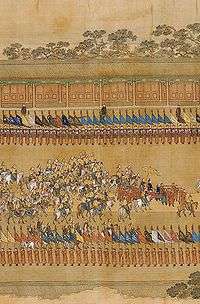
The early Qing military was rooted in the Eight Banners first developed by Nurhaci to organize Jurchen society beyond petty clan affiliations. There were eight banners in all, differentiated by color. The yellow, bordered yellow, and white banners were known as the "Upper Three Banners" and were under the direct command of the emperor. Only Manchus belonging to the Upper Three Banners, and selected Han Chinese who had passed the highest level of martial exams could serve as the emperor's personal bodyguards. The remaining Banners were known as the "Lower Five Banners." They were commanded by hereditary Manchu princes descended from Nurhachi's immediate family, known informally as the "Iron cap princes". Together they formed the ruling council of the Manchu nation as well as high command of the army. Nurhachi's son Hong Taiji expanded the system to include mirrored Mongol and Han Banners. After capturing Beijing in 1644, the relatively small Banner armies were further augmented by the Green Standard Army, made up of those Ming troops who had surrendered to the Qing, which eventually outnumbered Banner troops three to one. They maintained their Ming era organization and were led by a mix of Banner and Green Standard officers.
Banner Armies were organized along ethnic lines, namely Manchu and Mongol, but included non-Manchu bondservants registered under the household of their Manchu masters. The years leading up to the conquest increased the number of Han Chinese under Manchu rule, leading Hong Taiji to create the Eight Han Banners, and around the time of the Qing takeover of Beijing, their numbers rapidly swelled.[109] Han Bannermen held high status and power in the early Qing period, especially immediately after the conquest during Shunzhi and Kangxi's reign where they dominated Governor-Generalships and Governorships across China at the expense of both Manchu Bannermen and Han civilians. Han also numerically dominated the Banners up until the mid 18th century. European visitors in Beijing called them "Tartarized Chinese" or "Tartarified Chinese". It was in Qianlong's reign that the Qianlong Emperor, concerned about maintaining Manchu identity, re-emphasized Manchu ethnicity, ancestry, language, and culture in the Eight Banners and started a mass discharge of Han Bannermen from the Eight Banners, either asking them to voluntarily resign from the Banner rolls or striking their names off. This led to a change from Han majority to a Manchu majority within the Banner system,[110] and previous Han Bannermen garrisons in southern China such as at Fuzhou, Zhenjiang, Guangzhou, were replaced by Manchu Bannermen in the purge, which started in 1754. The turnover by Qianlong most heavily impacted Han banner garrisons stationed in the provinces while it less impacted Han Bannermen in Beijing, leaving a larger proportion of remaining Han Bannermen in Beijing than the provinces.[111] Han Bannermen's status was decreased from that point on with Manchu Banners gaining higher status. Han Bannermen numbered 75% in 1648 Shunzhi's reign, 72% in 1723 Yongzheng's reign, but decreased to 43% in 1796 during the first year of Jiaqing's reign, which was after Qianlong's purge. The mass discharge was known as the Disbandment of the Han Banners. Qianlong directed most of his ire at those Han Bannermen descended from defectors who joined the Qing after the Qing passed through the Great Wall at Shanhai Pass in 1644, deeming their ancestors as traitors to the Ming and therefore untrustworthy, while retaining Han Bannermen who were descended from defectors who joined the Qing before 1644 in Liaodong and marched through Shanhai pass, also known as those who "followed the Dragon through the pass" (從龍入關; cong long ru guan).
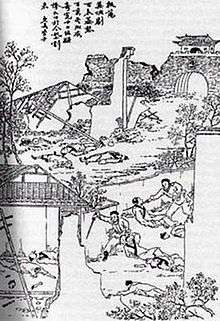
After a century of peace the Manchu Banner troops lost their fighting edge. Before the conquest, the Manchu banner had been a "citizen" army whose members were farmers and herders obligated to provide military service in times of war. The decision to turn the banner troops into a professional force whose every need was met by the state brought wealth, corruption, and decline as a fighting force. The Green Standard Army declined in a similar way.
Rebellion and modernization

Early during the Taiping Rebellion, Qing forces suffered a series of disastrous defeats culminating in the loss of the regional capital city of Nanjing in 1853. Shortly thereafter, a Taiping expeditionary force penetrated as far north as the suburbs of Tianjin, the imperial heartlands. In desperation the Qing court ordered a Chinese official, Zeng Guofan, to organize regional and village militias into an emergency army called tuanlian. Zeng Guofan's strategy was to rely on local gentry to raise a new type of military organization from those provinces that the Taiping rebels directly threatened. This new force became known as the Xiang Army, named after the Hunan region where it was raised. The Xiang Army was a hybrid of local militia and a standing army. It was given professional training, but was paid for out of regional coffers and funds its commanders — mostly members of the Chinese gentry — could muster. The Xiang Army and its successor, the Huai Army, created by Zeng Guofan's colleague and mentee Li Hongzhang, were collectively called the "Yong Ying" (Brave Camp).[112]
Zeng Guofan had no prior military experience. Being a classically educated official, he took his blueprint for the Xiang Army from the Ming general Qi Jiguang, who, because of the weakness of regular Ming troops, had decided to form his own "private" army to repel raiding Japanese pirates in the mid-16th century. Qi Jiguang's doctrine was based on Neo-Confucian ideas of binding troops' loyalty to their immediate superiors and also to the regions in which they were raised. Zeng Guofan's original intention for the Xiang Army was simply to eradicate the Taiping rebels. However, the success of the Yongying system led to its becoming a permanent regional force within the Qing military, which in the long run created problems for the beleaguered central government.
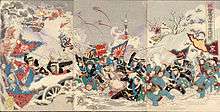
First, the Yongying system signaled the end of Manchu dominance in Qing military establishment. Although the Banners and Green Standard armies lingered on as a drain on resources, henceforth the Yongying corps became the Qing government's de facto first-line troops. Second, the Yongying corps were financed through provincial coffers and were led by regional commanders, weakening central government's grip on the whole country. Finally, the nature of Yongying command structure fostered nepotism and cronyism amongst its commanders, who laid the seeds of regional warlordism in the first half of the 20th century.[113]

By the late 19th century, the most conservative elements within the Qing court could no longer ignore China's military weakness. In 1860, during the Second Opium War, the capital Beijing was captured and the Summer Palace sacked by a relatively small Anglo-French coalition force numbering 25,000. The advent of modern weaponry resulting from the European Industrial Revolution had rendered China's traditionally trained and equipped army and navy obsolete. The government attempts to modernize during the Self-Strengthening Movement were initially successful, but yielded few lasting results because of the central government's lack of funds, lack of political will, and unwillingness to depart from tradition.[114]
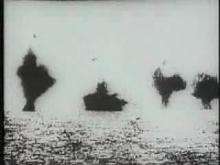
Losing the First Sino-Japanese War of 1894–1895 was a watershed. Japan, a country long regarded by the Chinese as little more than an upstart nation of pirates, annihilated the Qing government's modernized Beiyang Fleet, then deemed to be the strongest naval force in Asia. The Japanese victory occurred a mere three decades after the Meiji Restoration set a feudal Japan on course to emulate the Western nations in their economic and technological achievements. Finally, in December 1894, the Qing government took concrete steps to reform military institutions and to re-train selected units in westernized drills, tactics and weaponry. These units were collectively called the New Army. The most successful of these was the Beiyang Army under the overall supervision and control of a former Huai Army commander, General Yuan Shikai, who used his position to build networks of loyal officers and eventually become President of the Republic of China.[115]
Society

The most significant fact of early and mid-Qing social history was population growth. The population doubled during the 18th century. People in this period were also remarkably on the move. There is evidence suggesting that the empire's rapidly expanding population was geographically mobile on a scale, which, in term of its volume and its protracted and routinized nature, was unprecedented in Chinese history. Indeed, the Qing government did far more to encourage mobility than to discourage it. Migration took several different forms, though might be divided in two varieties: permanent migration for resettlement, and relocation conceived by the party (in theory at least) as a temporary sojourn. Parties to the latter would include the empire's increasingly large and mobile manual workforce, as well as its densely overlapping internal diaspora of local-origin-based merchant groups. It would also included the patterned movement of Qing subjects overseas, largely to Southeastern Asia, in search of trade and other economic opportunities.[116]
According to statute, Qing society was divided into relatively closed estates, of which in most general terms there were five. Apart from the estates of the officials, the comparatively minuscule aristocracy, and the degree-holding literati, there also existed a major division among ordinary Chinese between commoners and people with inferior status.[117] They were divided into two categories: one of them, the good "commoner" people, the other "mean" people. The majority of the population belonged to the first category and were described as liangmin, a legal term meaning good people, as opposed to jianmin meaning the mean (or ignoble) people. Qing law explicitly stated that the traditional four occupational groups of scholars, farmers, artisans and merchants were "good", or having a status of commoners. On the other hand, slaves or bondservants, entertainers (including prostitutes and actors), and those low-level employees of government officials were the "mean people". Mean people were considered legally inferior to commoners and suffered unequal treatments, forbidden to take the imperial examination.[118]
Economy
By the end of the 17th century, the Chinese economy had recovered from the devastation caused by the wars in which the Ming dynasty were overthrown, and the resulting breakdown of order.[119] In the following century, markets continued to expand as in the late Ming period, but with more trade between regions, a greater dependence on overseas markets and a greatly increased population.[120] After the re-opening of the southeast coast, which had been closed in the late 17th century, foreign trade was quickly re-established, and was expanding at 4% per annum throughout the latter part of the 18th century.[121] China continued to export tea, silk and manufactures, creating a large, favorable trade balance with the West.[122] The resulting inflow of silver expanded the money supply, facilitating the growth of competitive and stable markets.[123]
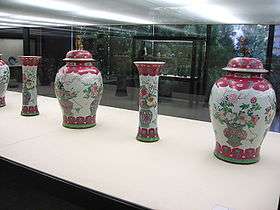
The government broadened land ownership by returning land that had been sold to large landowners in the late Ming period by families unable to pay the land tax.[124] To give people more incentives to participate in the market, they reduced the tax burden in comparison with the late Ming, and replaced the corvée system with a head tax used to hire laborers.[125] The administration of the Grand Canal was made more efficient, and transport opened to private merchants.[126] A system of monitoring grain prices eliminated severe shortages, and enabled the price of rice to rise slowly and smoothly through the 18th century.[127] Wary of the power of wealthy merchants, Qing rulers limited their trading licenses and usually refused them permission to open new mines, except in poor areas.[128] These restrictions on domestic resource exploration, as well as on foreign trade, are held by some scholars as a cause of the Great Divergence, by which the Western world overtook China economically.
By the end of the 18th century the population had risen to 300 million from approximately 150 million during the late Ming dynasty. The dramatic rise in population was due to several reasons, including the long period of peace and stability in the 18th century and the import of new crops China received from the Americas, including peanuts, sweet potatoes and maize. New species of rice from Southeast Asia led to a huge increase in production. Merchant guilds proliferated in all of the growing Chinese cities and often acquired great social and even political influence. Rich merchants with official connections built up huge fortunes and patronized literature, theater and the arts. Textile and handicraft production boomed.[122]
Arts and culture

Under the Qing, traditional forms of art flourished and innovations occurred at many levels and in many types. High levels of literacy, a successful publishing industry, prosperous cities, and the Confucian emphasis on cultivation all fed a lively and creative set of cultural fields.
The Qing emperors were generally adept at poetry and often skilled in painting, and offered their patronage to Confucian culture. The Kangxi and Qianlong Emperors, for instance, embraced Chinese traditions both to control them and to proclaim their own legitimacy. The Kangxi Emperor sponsored the Peiwen Yunfu, a rhyme dictionary published in 1711, and the Kangxi Dictionary published in 1716, which remains to this day an authoritative reference. The Qianlong Emperor sponsored the largest collection of writings in Chinese history, the Siku Quanshu, completed in 1782. Court painters made new versions of the Song masterpiece, Zhang Zeduan's Along the River During the Qingming Festival whose depiction of a prosperous and happy realm demonstrated the beneficence of the emperor. The emperors undertook tours of the south and commissioned monumental scrolls to depict the grandeur of the occasion.[129] Imperial patronage also encouraged the industrial production of ceramics and Chinese export porcelain.
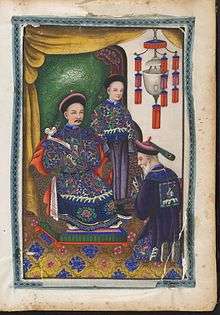
Yet the most impressive aesthetic works were done among the scholars and urban elite. Calligraphy and painting[130] remained a central interest to both court painters and scholar-gentry who considered the Four Arts part of their cultural identity and social standing.[131] The painting of the early years of the dynasty included such painters as the orthodox Four Wangs and the individualists Bada Shanren (1626–1705) and Shitao (1641–1707). The nineteenth century saw such innovations as the Shanghai School and the Lingnan School[132] which used the technical skills of tradition to set the stage for modern painting.
Traditional learning flourished, especially among Ming loyalists such as Dai Zhen and Gu Yanwu, but scholars in the school of evidential learning made innovations in skeptical textual scholarship. Scholar-bureaucrats, including Lin Zexu and Wei Yuan, developed a school of practical statecraft which rooted bureaucratic reform and restructuring in classical philosophy.

Literature grew to new heights in the Qing period. Poetry continued as a mark of the cultivated gentleman, but women wrote in larger and larger numbers and poets came from all walks of life. The poetry of the Qing dynasty is a lively field of research, being studied (along with the poetry of the Ming dynasty) for its association with Chinese opera, developmental trends of Classical Chinese poetry, the transition to a greater role for vernacular language, and for poetry by women in Chinese culture. The Qing dynasty was a period of much literary collection and criticism, and many of the modern popular versions of Classical Chinese poems were transmitted through Qing dynasty anthologies, such as the Quantangshi and the Three Hundred Tang Poems. Pu Songling brought the short story form to a new level in his Strange Stories from a Chinese Studio, published in the mid-18th century, and Shen Fu demonstrated the charm of the informal memoir in Six Chapters of a Floating Life, written in the early 19th century but published only in 1877. The art of the novel reached a pinnacle in Cao Xueqin's Dream of the Red Chamber, but its combination of social commentary and psychological insight were echoed in highly skilled novels such as Wu Jingzi's The Scholars (1750) and Li Ruzhen's Flowers in the Mirror (1827).[133]
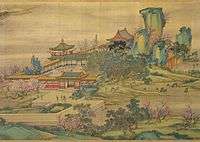
In drama, Kong Shangren's Kunqu opera The Peach Blossom Fan, completed in 1699, portrayed the tragic downfall of the Ming dynasty in romantic terms. The most prestigious form became the so-called Peking opera, though local and folk opera were also widely popular.
Cuisine aroused a cultural pride in the accumulated richness of a long and varied past. The gentleman gourmet, such as Yuan Mei, applied aesthetic standards to the art of cooking, eating, and appreciation of tea at a time when New World crops and products entered everyday life. The Suiyuan Shidan written by him, detailed the culinary esthetics and theory, along with a wide range of recipes from the ruling period of Qianlong during Qing Dynasty. The Manchu Han Imperial Feast originated at the court. Although this banquet was probably never common, it reflected an appreciation by Han Chinese for Manchu culinary customs.[134] Nevertheless, culinary traditionalists such as Yuan Mei lambasted the opulent culinary rituals of the Manchu Han Imperial Feast, saying that it is cause in part by "...the vulgar habits of bad chefs" and that "Display this trite are useful only for welcoming new relations through one’s gates or when the boss comes to visit." (皆惡廚陋習。只可用之於新親上門,上司入境)[135]
By the end of the nineteenth century, all elements of national artistic and cultural life had recognized and begun to come to terms with world culture as found in the West and Japan. Whether to stay within old forms or welcome Western models was now a conscious choice rather than an unchallenged acceptance of tradition. Classically trained Confucian scholars such as Liang Qichao and Wang Guowei broke ground later cultivated in the New Culture Movement.
See also
Notes
- ↑ The exact figure of Li Zicheng's forces at the battle of Shanhai Pass is disputed. Some primary sources, such as the official Qing and Ming court histories (Chinese: 《清世祖實錄》, 《明史》), cite 200,000. Modern historians generally estimate Li Zicheng's army to be no larger than 100,000.
- ↑ This event was recorded by Italian Jesuit Martin Martinius in his account Bellum Tartaricum with original text in Latin, first published in Rome 1654. First English edition, London: John Crook, 1654.
- ↑ Chinese: 六部; pinyin: lìubù
- ↑ simplified Chinese: 尚书; traditional Chinese: 尚書; pinyin: shàngshū; Manchu: ᠠᠯᡳᡥᠠ
ᠠᠮᠪᠠᠨ; Möllendorff: aliha amban; Abkai: aliha amban - ↑ Chinese: 侍郎; pinyin: shìláng; Manchu: ᠠᠰᡥᠠᠨ ᡳ
ᠠᠮᠪᠠᠨ; Möllendorff: ashan i amban; Abkai: ashan-i amban - ↑ simplified Chinese: 内阁; traditional Chinese: 內閣; pinyin: nèigé; Manchu: ᡩᠣᡵᡤᡳ
ᠶᠠᠮᡠᠨ; Möllendorff: dorgi yamun; Abkai: dorgi yamun - ↑ simplified Chinese: 军机处; traditional Chinese: 軍機處; pinyin: jūnjī chù; Manchu: ᠴᠣᡠᡥᠠᡳ
ᠨᠠᠰᡥᡡᠨ ᡳ
ᠪᠠ; Möllendorff: coohai nashūn i ba; Abkai: qouhai nashvn-i ba - ↑ simplified Chinese: 军机大臣; traditional Chinese: 軍機大臣; pinyin: jūnjī dàchén
- ↑ Chinese: 吏部; pinyin: lìbù; Manchu: ᡥᠠᡶᠠᠨ ᡳ
ᠵᡠᡵᡤᠠᠨ; Möllendorff: hafan i jurgan; Abkai: hafan-i jurgan - ↑ Chinese: 户部; pinyin: hùbù; Manchu: ᠪᠣᡳᡤᠣᠨ ᡳ
ᠵᡠᡵᡤᠠᠨ; Möllendorff: boigon i jurgan; Abkai: boigon-i jurgan - ↑ simplified Chinese: 礼部; traditional Chinese: 禮部; pinyin: lǐbù; Manchu: ᡩᠣᡵᠣᠯᠣᠨ ᡳ
ᠵᡠᡵᡤᠠᠨ; Möllendorff: dorolon i jurgan; Abkai: dorolon-i jurgan - ↑ Chinese: 兵部; pinyin: bīngbù; Manchu: ᠴᠣᡠᡥᠠᡳ
ᠵᡠᡵᡤᠠᠨ; Möllendorff: coohai jurgan; Abkai: qouhai jurgan - ↑ Chinese: 刑部; pinyin: xíngbù; Manchu: ᠪᡝᡳᡩᡝᡵᡝ
ᠵᡠᡵᡤᠠᠨ; Möllendorff: beidere jurgan; Abkai: beidere jurgan - ↑ Chinese: 工部; pinyin: gōngbù; Manchu: ᠸᡝᡳᠯᡝᡵᡝ
ᠵᡠᡵᡤᠠᠨ; Möllendorff: weilere jurgan; Abkai: weilere jurgan - ↑ Chinese: 包衣; pinyin: bāoyī; Manchu: ᠪᠣᡠᡳ; Möllendorff: booi; Abkai: boui
References
Citations
- ↑ Elliott (2001), pp. 290–291.
- ↑ Legrand, Jacques. Chronicle of the 20th Century. 1992. Page 155.
- ↑ Turchin, Peter; Adams, Jonathan M.; Hall, Thomas D. (26 Aug 2015). "East-West Orientation of Historical Empires and Modern States". Journal of World-Systems Research. 12 (2): 222. doi:10.5195/jwsr.2006.369. ISSN 1076-156X.
- ↑ Taagepera, Rein (Sep 1997). "Expansion and Contraction Patterns of Large Polities: Context for Russia". International Studies Quarterly. 41 (3): 500. doi:10.1111/0020-8833.00053. JSTOR 2600793.
- ↑ Elliott (2001), p. 56.
- ↑ Yamamuro, Shin'ichi (2006). Manchuria Under Japanese Domination. Translated by J. A. Fogel. University of Pennsylvania Press. p. 246. ISBN 9780812239126.
- ↑ Crossley (1997), pp. 212–3.
- ↑ Elliott (2001), p. 402, note 118.
- ↑ Treaty of Nanking. 1842.
- ↑ McKinley, William. "Second State of the Union Address". 5 Dec. 1898.
- ↑ Zhao (2006), pp. n 4, 7–10, and 12–14.
- ↑ Bilik, Naran. "Names Have Memories: History, Semantic Identity and Conflict in Mongolian and Chinese Language Use." Inner Asia 9.1 (2007): 23–39. p. 34
- ↑ Ebrey (2010), p. 220.
- ↑ Pamela Crossley, The Manchus, p. 3
- ↑ Patricia Buckley Ebrey et al., East Asia: A Cultural, Social, and Political History, 3rd edition, p. 271
- ↑ Frederic Wakeman, Jr., The Great Enterprise: The Manchu Reconstruction of Imperial Order in the Seventeenth Century, p. 24, note 1
- 1 2 Ebrey (2010), pp. 220–224.
- 1 2 Bernard Hung-Kay Luk, Amir Harrak-Contacts between cultures, Volume 4, p.25
- ↑ David Andrew Graff; Robin Higham (2012). A Military History of China. University Press of Kentucky. pp. 116–. ISBN 0-8131-3584-2.
- ↑ David Andrew Graff; Robin Higham (2012). A Military History of China. University Press of Kentucky. pp. 117–. ISBN 0-8131-3584-2.
- ↑ David Andrew Graff; Robin Higham (2012). A Military History of China. University Press of Kentucky. pp. 118–. ISBN 0-8131-3584-2.
- ↑ Shuo Wang, "Qing Imperial Women: Empresses, Concubines, and Aisin Gioro Daughters," in Anne Walthall, ed., Servants of the Dynasty: Palace Women in World History (Berkeley: University of California Press, 2008) p. 148.
- ↑ Wakeman 1977, p. 79.
- ↑ Crossley, 2010, p. 95.
- ↑ Anne Walthall (2008). Servants of the Dynasty: Palace Women in World History. University of California Press. pp. 154–. ISBN 978-0-520-25444-2.
- ↑ Wakeman, Jr, Frederic (1985). The great enterprise : the Manchu reconstruction of imperial order in seventeenth-century China (Book on demand. ed.). Berkeley: University of California Press. p. 892. ISBN 9780520048041.
- ↑ 梨大史學會 (Korea) (1968). 梨大史苑, Volume 7. 梨大史學會. p. 105.
- ↑ Li (2002), pp. 60–62.
- ↑ Encyclopædia Britannica: China » History » The early Qing dynasty » The rise of the Manchu
- ↑ The Cambridge History of China: Pt. 1 ; The Ch'ing Empire to 1800. Cambridge University Press. 1978. pp. 65–. ISBN 978-0-521-24334-6.
- ↑ Spence (2012), p. 32.
- ↑ Naquin 1987, p. 141.
- ↑ Evelyn S. Rawski, "Ch'ing Imperial Marriage and Problems of Rulership," in Watson, Ebrey eds. Marriage and Inequality in Chinese Society (Berkeley: University of California Press, 1991 p. 175.
- ↑ Spence 1990, p. 41.
- ↑ Spence 1988, pp. 4–5.
- ↑ Di Cosmo 2007, p. 6.
- ↑ Di Cosmo 2007, p. 7.
- ↑ Di Cosmo 2007, p. 9.
- 1 2 Di Cosmo 2007, p. 23.
- ↑ Wakeman 1986, p. 478.
- ↑ Wakeman (1986), p. 858.
- ↑ Evelyn S. Rawski (15 November 1998). The Last Emperors: A Social History of Qing Imperial Institutions. University of California Press. pp. 72–. ISBN 978-0-520-92679-0.
- 1 2 Spence (2012), p. 38.
- ↑ Wakeman (1986), pp. 646–650.
- ↑ Wakeman (1986), p. 648, n. 183.
- ↑ Wakeman (1986), pp. 651–80.
- ↑ Faure (2007), p. 164.
- ↑ Ebrey (1993).
- ↑ Wakeman 1975, p. 83.
- ↑ Ho (2011), p. 135.
- ↑ Ho (2011), p. 198.
- ↑ Ho (2011), p. 206.
- ↑ Ho (2011), p. 307.
- ↑ Rowe (2009), pp. 32–33.
- ↑ Alexander Golikov, Translating through the Cultural Barriers: the Qing Imperial Multilingualism
- ↑ Farquhar, David (1978). "Emperor As Bodhisattva in the Governance of the Qing Empire". Harvard Journal of Asiatic Studies. 38 (1): 5–34. doi:10.2307/2718931.
- ↑ Spence (2012), pp. 48–51.
- ↑ Di Cosmo 2007, pp. 24–25.
- ↑ Di Cosmo 2007, p. 15.
- 1 2 Di Cosmo 2007, p. 17.
- ↑ [Sealords live in vain : Fujian and the making of a maritime frontier in seventeenth-century China p. 307.
- ↑ David Andrew Graff; Robin Higham (2012). A Military History of China. University Press of Kentucky. pp. 119–. ISBN 0-8131-3584-2.
- ↑ David Andrew Graff; Robin Higham (2012). A Military History of China. University Press of Kentucky. pp. 120–. ISBN 0-8131-3584-2.
- ↑ David Andrew Graff; Robin Higham (2012). A Military History of China. University Press of Kentucky. pp. 121–122. ISBN 0-8131-3584-2.
- ↑ Perdue (2005).
- ↑ Manthorpe 2008, p. 108.
- ↑ Spence (2012), pp. 62–66.
- ↑ Spence (2012), p. 72.
- ↑ Hsü (1990), p. 35.
- ↑ Rowe (2009), p. 68.
- ↑ Hsü (1990), pp. 35–37.
- ↑ Spence (2012), pp. 80–83.
- ↑ Spence (2012), pp. 83, 86.
- ↑ "In Chinese:康乾盛世"的文化專制與文字獄". china.com. Retrieved 2008-12-30.
- ↑ Schoppa, R. Keith. Revolution and its Past: Identities and Change in Modern Chinese History. Pearson Hall, 2010, pgs. 42–43.
- ↑ Elliott (2000), p. 617.
- ↑ Bulag 2012, p. 41.
- ↑ Richards 2003, p. 141.
- ↑ Reardon-Anderson 2000, p. 504.
- ↑ Reardon-Anderson 2000, p. 505.
- ↑ Reardon-Anderson 2000, p. 506.
- ↑ Scharping 1998, p. 18.
- ↑ Reardon-Anderson 2000, p. 507.
- ↑ Reardon-Anderson 2000, p. 508.
- ↑ Reardon-Anderson 2000, p. 509.
- ↑ The New Encyclopædia Britannica, p357
- ↑ Têng & Fairbank (1954), p. 19.
- ↑ Platt (2012), p. xxii.
- ↑ Wright (1957), pp. 196–221.
- ↑ Paul H. Clyde and Burton F. Beers, The Far East: A history of Western impacts and Eastern responses, 1830–1975 (6th ed. 1975) pp 193–4
- ↑ Crossley (2010).
- ↑ Reynolds (1993), pp. 35–36.
- ↑ Spence (2012), pp. 223–225.
- ↑ Kaske (2008), p. 235.
- ↑ Mu, Eric. Reformist Emperor Guangxu was Poisoned, Study Confirms". Danwei. 3 November 2008. Accessed 13 February 2013.
- ↑ Chien-nung Li, Jiannong Li, Ssŭ-yü Têng, "The political history of China, 1840–1928", p234
- ↑ Spence (2012), p. 39.
- ↑ Beverly Jackson and David Hugus Ladder to the Clouds: Intrigue and Tradition in Chinese Rank (Ten Speed Press, 1999) pp. 134–135.
- ↑ Bartlett (1991).
- ↑ "The Rise of the Manchus". University of Maryland. Retrieved 2008-10-19.
- 1 2 Rawski (1998), p. 179.
- ↑ Rawski (1998), pp. 179–180.
- ↑ Torbert (1977), p. 27.
- ↑ Torbert (1977), p. 28.
- ↑ Elliott (2000), pp. 603–646.
- ↑ James A. Millward (2007). Eurasian crossroads: a history of Xinjiang. Columbia University Press. p. 190. ISBN 0-231-13924-1.
- ↑ The New York Times, Jan 19, 1906
- ↑ Convention Between Great Britain and China Respecting Tibet (1906)
- ↑ Naquin (2000), p. 372.
- ↑ Naquin (2000), p. 380.
- ↑ CrossleySiuSutton (2006), p. 50.
- ↑ Liu & Smith (1980), pp. 202–211.
- ↑ Liu & Smith (1980), pp. 202–210.
- ↑ Wakeman (1977?)
- ↑ Liu & Smith (1980), pp. 251–273.
- ↑ Rowe (2002), pp. 480–481.
- ↑ Rowe (2002), p. 485.
- ↑ Naquin & Rawski (1987), p. 117.
- ↑ Myers & Wang (2002), pp. 564, 566.
- ↑ Myers & Wang (2002), p. 564.
- ↑ Myers & Wang (2002), p. 587.
- 1 2 Murphey (2007), p. 151.
- ↑ Myers & Wang (2002), pp. 587, 590.
- ↑ Myers & Wang (2002), p. 593.
- ↑ Myers & Wang (2002), pp. 593, 595.
- ↑ Myers & Wang (2002), p. 598.
- ↑ Myers & Wang (2002), pp. 572–573, 599–600.
- ↑ Myers & Wang (2002), pp. 606, 609.
- ↑ “Recording the Grandeur of the Qing.” Chinese painting
- ↑ Minneapolis Institute of Arts
- ↑ “Qing Dynasty, Painting,” Metropolitan Museum of Art
- ↑ "The Lingnan School of Painting,"
- ↑ "Ming and Qing Novels," Berkshire Encyclopedia
- ↑ Jonathan Spence, "Ch'ing," in Kwang-chih Chang, ed., Food in Chinese Culture: Anthropological and Historical Perspectives (New Haven: Yale University Press, 1977): 260–294, reprinted in Jonathan Spence, Chinese Roundabout: Essays in History and Culture (New York: W.W. Norton, 1992).
- ↑ "River Delicacies 6: Imitation Crab (假蟹)River Delicacies 6: Imitation Crab (假蟹)". Translating the Suiyuan Shidan. 2014-09-05.
Works cited
- Bartlett, Beatrice S. (1991), Monarchs and Ministers: The Grand Council in Mid-Ch'ing China, 1723–1820, Berkeley and Los Angeles: University of California Press, ISBN 978-0-520-06591-8.
- Crossley, Pamela Kyle (1997), The Manchus, Wiley, ISBN 978-1-55786-560-1.
- —— (2010), The Wobbling Pivot: China since 1800, Malden, MA: Wiley-Blackwell, ISBN 978-1-4051-6079-7.
- Crossley, Pamela Kyle; Siu, Helen F.; Sutton, Donald S. (2006), Empire at the Margins: Culture, Ethnicity, and Frontier in Early Modern China, University of California Press, ISBN 0-520-23015-9.
- Ebrey, Patricia (1993), Chinese Civilization: A Sourcebook (2nd ed.), New York: Simon and Schuster, ISBN 978-0-02-908752-7.
- —— (2010), The Cambridge Illustrated History of China, Cambridge University Press, ISBN 978-0-521-12433-1.
- Elliott, Mark C. (2000), "The Limits of Tartary: Manchuria in Imperial and National Geographies" (PDF), Journal of Asian Studies, 59: 603–646, doi:10.2307/2658945, JSTOR 2658945.
- —— (2001), The Manchu Way: The Eight Banners and Ethnic Identity in Late Imperial China, Stanford University Press, ISBN 978-0-8047-4684-7.
- Elliott, Mark C.; Chia, Ning (2004), "The Qing Hunt at Mulan", in Dunnell, Ruth W.; Elliott, Mark C.; Foret, Philippe; et al., New Qing Imperial History: The Making of Inner Asian Empire at Qing Chengde, Routledge, pp. 66–83, ISBN 978-1-134-36222-6.
- Faure, David (2007), Emperor and Ancestor: State and Lineage in South China, Stanford University Press, ISBN 978-0-8047-5318-0.
- Ho, David Dahpon (2011). Sealords Live in Vain: Fujian and the Making of a Maritime Frontier in Seventeenth-Century China. University of California, San Diego.
- Hsü, Immanuel C. Y. (1990), The rise of modern China (4th ed.), New York: Oxford University Press, ISBN 978-0-19-505867-3.
- Kaske, Elisabeth (2008), The politics of language in Chinese education, 1895–1919, Leiden: BRILL, ISBN 978-90-04-16367-6.
- Li, Gertraude Roth (2002), "State building before 1644", in Peterson, Willard, The Ch'ing Empire to 1800, The Cambridge History of China, 9, Cambridge: Cambridge University Press, pp. 9–72, ISBN 978-0-521-24334-6.
- Liu, Kwang-Ching; Smith, Richard J. (1980), "The Military Challenge: The North-west and the Coast", in Fairbank, John K.; Liu, Kwang-Ching, Late Ch'ing, 1800–1911, Part 2, Cambridge History of China, 11, Cambridge, England: Cambridge University Press, pp. 202–273, ISBN 978-0-521-22029-3.
- Murphey, Rhoads (2007), East Asia: A New History (4th ed.), Pearson Longman, ISBN 978-0-321-42141-8.
- Myers, H. Ramon; Wang, Yeh-Chien (2002), "Economic developments, 1644–1800", in Peterson, Willard, The Ch'ing Empire to 1800, The Cambridge History of China, 9, Cambridge: Cambridge University Press, pp. 563–647, ISBN 978-0-521-24334-6.
- Naquin, Susan; Rawski, Evelyn Sakakida (1987), Chinese Society in the Eighteenth Century, Yale University Press, ISBN 978-0-300-04602-1.
- Naquin, Susan (2000), Peking: Temples and City Life, 1400-1900, University of California Press, ISBN 978-0-520-21991-5.
- Perdue, Peter C. (2005), China Marches West: The Qing Conquest of Central Eurasia, Harvard University Press, ISBN 978-0-674-01684-2.
- Platt, Stephen R. (2012), Autumn in the Heavenly Kingdom: China, the West, and the Epic Story of the Taiping Civil War, Alfred A. Knopf, ISBN 978-0-307-27173-0.
- Rawski, Evelyn S. (1998), The Last Emperors: A Social History of Qing Imperial Institutions, Berkeley and Los Angeles: University of California Press, ISBN 978-0-520-21289-3. Paperback edition (2001) ISBN 978-0-520-92679-0.
- Reynolds, Douglas Robertson (1993), China, 1898–1912 : The Xinzheng Revolution and Japan, Cambridge, Mass.: Council on East Asian Studies Harvard University : Distributed by Harvard University Press, ISBN 978-0-674-11660-3.
- Rowe, William T. (2002), "Social stability and social change", in Peterson, Willard, The Ch'ing Empire to 1800, The Cambridge History of China, 9, Cambridge: Cambridge University Press, pp. 473–562, ISBN 978-0-521-24334-6.
- —— (2009), China's Last Empire: The Great Qing, History of Imperial China, Cambridge, MA: Harvard University Press, ISBN 978-0-674-03612-3.
- Spence, Jonathan D. (2012), The Search for Modern China (3rd ed.), New York: Norton, ISBN 978-0-393-93451-9.
- Têng, Ssu-yü; Fairbank, John King, eds. (1954) [reprint 1979], China's Response to the West: A Documentary Survey, 1839–1923, Cambridge, MA: Harvard University Press, ISBN 978-0-674-12025-9.
- Torbert, Preston M. (1977), The Ch'ing Imperial Household Department: A Study of Its Organization and Principal Functions, 1662–1796, Harvard University Asia Center, ISBN 978-0-674-12761-6.
- Wakeman, Frederic E. (1975). The Fall of Imperial China. New York: Free Press. ISBN 0029336902.
- —— (1986), The Great Enterprise: The Manchu Reconstruction of Imperial Order in Seventeenth-century China, Berkeley and Los Angeles: University of California Press, ISBN 978-0-520-04804-1.
- Wright, Mary Clabaugh (1957), The Last Stand of Chinese Conservatism: The T'ung-Chih Restoration, 1862–1874, Stanford: Stanford University Press, ISBN 978-0-80470475-5.
- Zhao, Gang (2006), "Reinventing China Imperial Qing Ideology and the Rise of Modern Chinese National Identity in the Early Twentieth Century" (PDF), Modern China, 32 (1): 3–30, doi:10.1177/0097700405282349, JSTOR 20062627, archived from the original (PDF) on 25 March 2014.
Further reading
- Bickers, Robert (2011), The Scramble for China: Foreign Devils in the Qing Empire, 1832–1914, Penguin, ISBN 978-0-7139-9749-1.
- Cotterell, Arthur (2007), The Imperial Capitals of China – An Inside View of the Celestial Empire, London: Pimlico, ISBN 978-1-84595-009-5.
- Dunnell, Ruth W.; Elliott, Mark C.; Foret, Philippe; et al., eds. (2004), New Qing Imperial History: The Making of Inner Asian Empire at Qing Chengde, Routledge, ISBN 978-1-134-36222-6.
- Esherick, Joseph; Kayalı, Hasan; Van Young, Eric, eds. (2006), Empire to Nation: Historical Perspectives on the Making of the Modern World, Rowman & Littlefield, ISBN 978-0-7425-4031-6.
- Fairbank, John K.; Liu, Kwang-Ching, eds. (1980), Late Ch'ing 1800–1911, Part 2, The Cambridge History of China, 11, Cambridge: Cambridge University Press, ISBN 978-0-521-22029-3.
- Owen, Stephen, "The Qing Dynasty: Period Introduction," in Stephen Owen, ed. An Anthology of Chinese Literature: Beginnings to 1911. New York: W. W. Norton, 1997. p. 909-914. (Archive. (Archive).
- Paludan, Ann (1998), Chronicle of the Chinese Emperors, London: Thames & Hudson, ISBN 978-0-500-05090-3.
- Peterson, Willard, ed. (2003), The Ch'ing Empire to 1800, The Cambridge History of China, 11, Cambridge: Cambridge University Press, ISBN 978-0-521-24334-6.
- Rowe, William T. (2009), The Great Qing, Cambridge, MA: Harvard University Press, ISBN 978-0-674-03612-3.
- Smith, Richard Joseph (2015), The Qing Dynasty and Traditional Chinese Culture, Rowman and Littlefield, ISBN 978-1-4422-2193-2.
- Spence, Jonathan (1997), God's Chinese Son: The Taiping Heavenly Kingdom of Hong Xiuquan, New York: W. W. Norton & Company, ISBN 978-0-393-31556-1.
- Struve, Lynn A. (1968), Voices from the Ming-Qing Cataclysm: China in Tigers' Jaws, New Haven: Yale University Press, ISBN 978-0-300-07553-3.
- —— (2004), The Qing Formation in World-Historical Time, Harvard University Asia Center, ISBN 978-0-674-01399-5.
- Waley-Cohen, Joanna (2006), The culture of war in China: empire and the military under the Qing dynasty, I.B. Tauris, ISBN 978-1-84511-159-5.
- Woo, X.L. (2002), Empress dowager Cixi: China's last dynasty and the long reign of a formidable concubine: legends and lives during the declining days of the Qing dynasty, Algora Publishing, ISBN 978-1-892941-88-6.
- Zhao, Gang (2013), The Qing Opening to the Ocean: Chinese Maritime Policies, 1684–1757, University of Hawaii Press, ISBN 978-0-8248-3643-6.
Historiography
- Newby, L.J. (2011), "China: Pax Manjurica", Journal for Eighteenth-Century Studies, 34 (4): 557–563, doi:10.1111/j.1754-0208.2011.00454.x.
- Ho, Ping-Ti (1967), "The Significance of the Ch'ing Period in Chinese History", The Journal of Asian Studies, 26 (2): 189–195, doi:10.2307/2051924, JSTOR 2051924.
- —— (1998), "In Defense of Sinicization: A Rebuttal of Evelyn Rawski's 'Reenvisioning the Qing'", The Journal of Asian Studies, 57 (1): 123–155, doi:10.2307/2659026, JSTOR 2659026.
- Rawski, Evelyn S. (1996), "Reenvisioning the Qing: The Significance of the Qing Period in Chinese History", The Journal of Asian Studies, 55 (4): 829–850, doi:10.2307/2646525, JSTOR 2646525.
- Waley-Cohen, Joanna (2004), "The New Qing History", Radical History Review, 88 (1): 193–206, doi:10.1215/01636545-2004-88-193. A review essay on revisionist works.
- Wu, Guo. "New Qing History: Dispute, Dialog, and Influence" Chinese Historical Review (May 2016) 23#1 pp 47–69. Covers the New Qing History approach that arose in the U.S. in the 1980s and the responses to it.
External links
| Wikimedia Commons has media related to: |
- Section on the Ming and Qing dynasties of "China's Population: Readings and Maps." Retrieved on 2008-11-10.
| Preceded by Ming dynasty |
Dynasties in Chinese history 1644–1912 |
Succeeded by Republic of China |
Coordinates: 39°54′N 116°23′E / 39.900°N 116.383°E
.svg.png)

.svg.png)
